Music is the universal language
“Glory to God in the highest heaven, and on earth peace to those on whom his favor rests.” - Luke 2:14
Premier Guitar
Goose's Rick Mitarotonda: Can Jambands Write Great Songs? Yes!
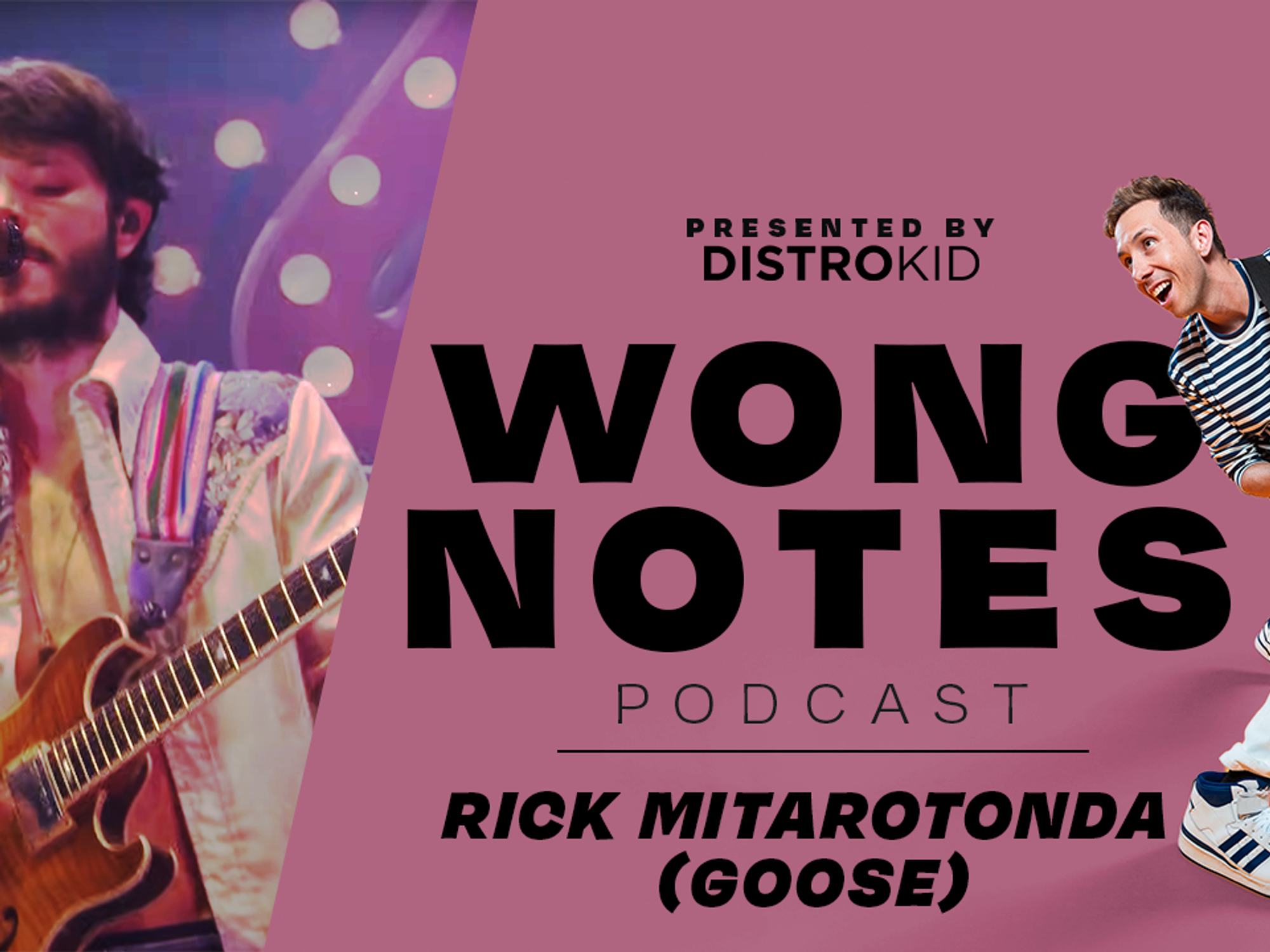
Cory Wong and Mitarotonda go deep on jambands, feeling misunderstood, and more.
Sound the alarms, tell your neighbors, hire a banner plane: Wong Notes is back. Cory Wong’s beloved podcast returns after a healthy break, and this exciting comeback episode features Wong in conversation with Goose’s Rick Mitarotonda.
The Connecticut rock band’s guitarist and vocalist talks through the band’s origins and position in the jam-band and broader music scenes, and Wong and Mitarotonda debate an ancient, critical question: Can jam bands actually write great songs?
The duo talk through their philosophies on recording, staying sharp on your instrument, all-star moments and standout players in the jam community, and feeling misunderstood as an artist. Like a good jam set, there are plenty of rich tangents, fascinating rabbit holes, and unexpected insights, so tune in and keep your ears open.
Blackstar Announces BEAM SOLO – Play Time.
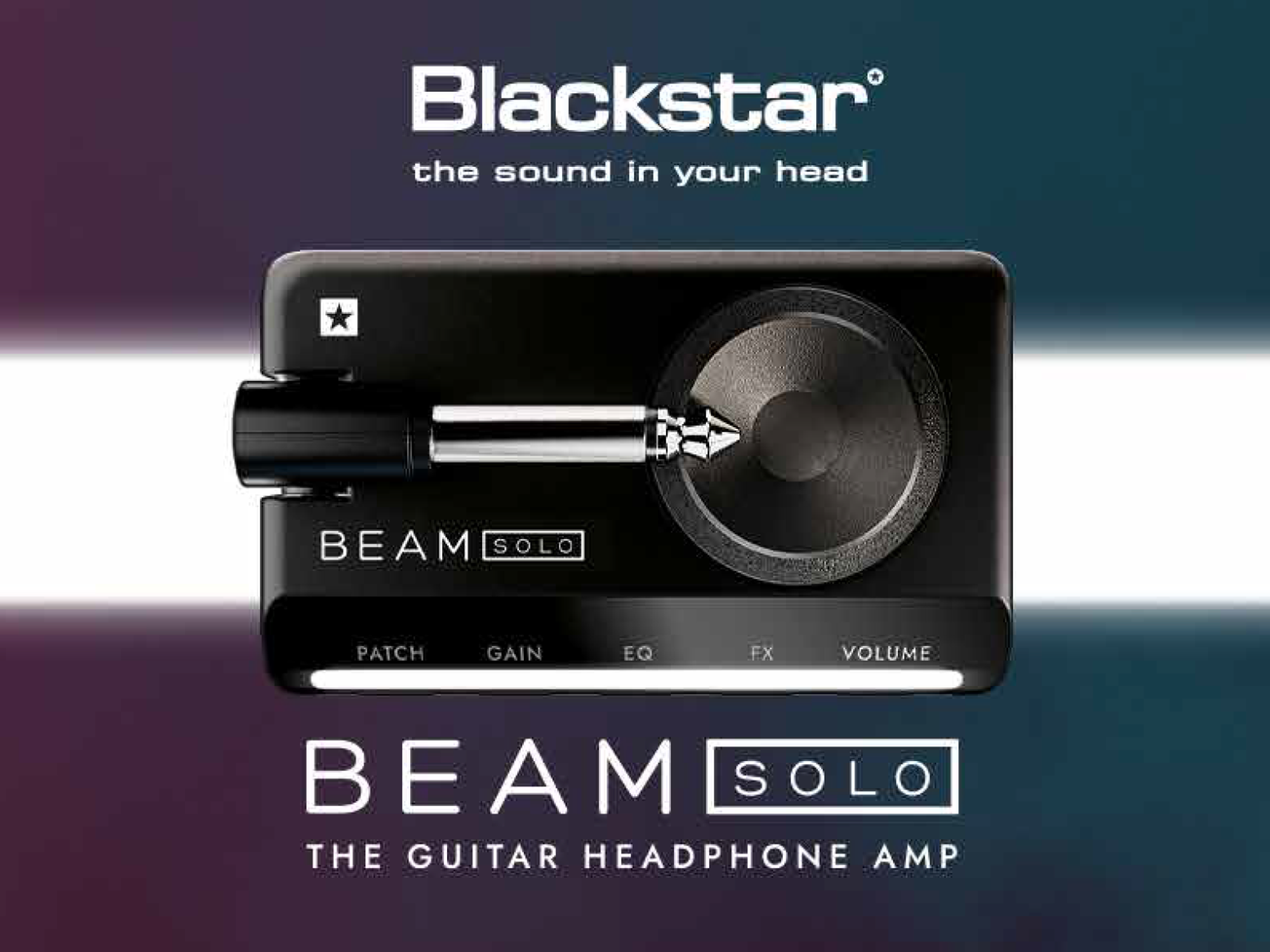
At Blackstar, we believe great tone should be ready whenever inspiration strikes. That’s why we created BEAM SOLO — the most immersive, intuitive headphone amp on the market today. Whether you’re jamming at home, on the move, or just grabbing ten minutes of play time between everything else, BEAM SOLO gives you pro-level sound with complete creative freedom — wherever you are.
Designed for electric, acoustic and bass guitars, BEAM SOLO fits in your hand, plugs straight into your headphones, and delivers the sound and feel of a real amp. You can shape your tone directly on the unit using the tactile SpeedDial and Light Beam Display, which give instant visual feedback with no menus to navigate. Or you can take full control through the BEAM app, where a growing library of professional-grade amp, cab, mic and pedal models is waiting. Combined with our patented ISF, you can access an infinite number of tonal possibilities to explore, enjoy and create with.
With our unique and immersive ‘In The Room’ technology, we’ve made the headphone experience feel alive — like a real amp, in a real space. Every note resonates with depth and presence, making even silent practice inspiring. A single expressive control called XpressFX lets you control multi-layered effects in real time, with smooth transitions that feel natural when adjusting. We’ve also added a headset mic input with studio-quality preamps and reverb, so you can truly immerse yourself with both guitar and vocals wherever you are, and jam along to your favourite tracks seamlessly via Bluetooth audio.
In addition to the authentic Blackstar amp models, BEAM SOLO also includes Ampton – our collection of classic software amplifiers, designed at Blackstar HQ in Northampton UK – home to our world-class R&D department. Built on decades of experience in both valve and digital amplifier design, Ampton fuses authentic valve character with advanced digital algorithms, developed by a design team with a unique technical heritage. The name itself is drawn from Northampton, reflecting the roots of our engineers and the history behind the company.
Ampton designs are more than just static profiles, they are the result of meticulous design, testing and optimisation – component by component, sector by sector. Starting with Blackstar founder Bruce Keir’s original digital models of our legendary Series One valve amplifiers, every element has been refined over decades. This dedication extends to the tiniest tonal interactions, from cathode follower behaviour to the modelling of preamp DC offsets, ensuring unmatched realism, tone and feel.
Another unique aspect of the Ampton designs are the completely accurate tone-stack models. These retain the exact interactivity between controls as the valve amp references, to deliver musicality and interactivity that a mere “capture” snapshot cannot. The power amplifier models go beyond traditional emulation, recreating the true interplay between valves, output transformers and speakers.
Our method blends deep analysis and literally hundreds of hours of critical listening. AB sonic tests are matched with precise electrical analysis, while the design team use their decades of voicing expertise. Every nuance is considered while intelligent optimisation results in elegant algorithms with extremely low latency.
If you head over to the BEAM app, you’ll find Official Artist Patches to explore from an ever growing list of all-stars including Doug Aldrich (The Dead Daisies), Gus G. (Firewind), Will Sergeant (Echo & The Bunnymen) and many more. You can join in the fun and share your own tones on the online community and download other creators’ patches within a vibrant global community of players just like you. You can even share your favourite patches over message to your friends with just a simple tap.
Within the ‘Music’ section of the app, you’ll find a host of backing tracks and video lessons to make sure that you can stay inspired and continue your learning journey. The BEAM SOLO is a complete one-stop solution for guitar players today.
We designed BEAM SOLO to give every guitarist the freedom to play and create anywhere, instantly, and without compromise. Whether you’re shaping your sound with a twist of the SpeedDial or diving deep into your rig choices via the app, it always feels intuitive and immersive. You can record vocals, jam with backing tracks, or just enjoy the feel of a cranked valve amp in your headphones — all from a device that fits in your pocket.
We’re constantly adding new sounds and features to the BEAM app, so your rig evolves with you. With ISF, XpressFX, SpeedDial, Light Beam Display and community connectivity, BEAM SOLO gives you the tools to stay inspired, have fun and sound incredible — wherever you are.
Alter Bridge Release First Track/Video “Silent Divide”
On the heels of the excitement from the recent announcements of their upcoming 8th studio album and their Blackbird festival in Wales next summer, acclaimed rockers Alter Bridge are releasing the first piece of music in over two years, “Silent Divide.” The track from the quartet comprised of Myles Kennedy on vocals/guitars, Mark Tremonti on guitars/vocals, Brian Marshall on bass and Scott Phillips on drums shows the band is back and ready to pick up where they left off in 2023. The brooding track begins with the signature guitar tones of Kennedy and Tremonti before the rhythm section of Marshall and Phillips join in. The chorus is powered by Kennedy’s haunting descent as he sings: “Keep your head down, ride out the silent divide.”
A music video for “Silent Divide” is also available today that the band has been teasing for days. A comedic opening skit was released of Tremonti, Marshall, and Phillips calling Kennedy’s mom to get the band back together as Myles hangs in his mom’s basement. That scene gives way to a performance of the 4 guys playing together in a small room – a throwback to the way it all started for them. The video was directed by JT Ibanez, and the song can be found in all formats here:
With more than two decades performing together, Alter Bridge show no signs of slowing down. The new, self-titled album from Napalm Records, Alter Bridge, is comprised of 12 all new tracks from the band and features some of their most iconic moments on record. Songs like “Rue The Day,” “Disregarded” and “Scales Are Falling” will fit alongside any of the classic songs from Alter Bridge’s catalog. “Trust In Me” shows Myles and Mark sharing vocal duties as Myles handles the verse duties while Mark takes the chorus. That strategy is flipped on “Tested And Able” as Mark handles the verses and Myles takes on the choruses behind one of the band’s heaviest intros to date, giving way to an unforgettable melody. The album closer “Slave To Master” is an epic track that Alter Bridge has come to be known for and is the longest song the quartet has recorded to date. The band worked with longtime collaborator and producer Michael “Elvis” Baskette on their eighth album. Alter Bridge will be released on January 9, 2026, and is now available for pre-order at: https://www.lnk.to/AB-AlterBridge.
The track listing for Alter Bridge is:
1) Silent Divide (5:06)
2) Rue The Day (4:46)
3) Power Down (4:08)
4) Trust In Me (4:48)
5) Disregarded (3:55)
6) Tested And Able (4:36)
7) What Lies Within (5:07)
8) Hang By A Thread (4:11)
9) Scales Are Falling (5:54)
10) Playing Aces (4:05)
11) What Are You Waiting For (5:00)
12) Slave To Master (9:03)
To coincide with the release of the new music, Alter Bridge is announcing a headline U.S. tour to accompany their already announced European tour. The band is heading out on the What Lies Within U.S. Tour featuring Filter or Sevendust and Tim Montana as support in select markets. The tour kicks off on April 25 in Orlando, FL and runs through May 24 where it wraps in Tampa, FL. Along the way, the tour will make stops in Dallas, TX (April 29), Chicago, IL (May 6) and Huntington, NY (May 12) to name a few. More information on all tickets and VIP packages for the upcoming tour can be found at www.alterbridge.com.
What Lies Within U.S. Tour
Apr 25 – Orlando, FL – House of Blues – TM
Apr 26 – Atlanta, GA – Coca-Cola Roxy – 7D/TM
Apr 28 – Houston, TX – Bayou Music Center – F/TM
Apr 29 – Dallas, TX – South Side Ballroom – F/TM
May 1 – Tulsa, OK – Skyline Event Center at Osage Casino Hotel – F/TM
May 2 – Omaha, NE – Steelhouse Omaha – F/TM
May 5 – Green Bay, WI – EPIC Event Center – F/TM
May 6 – Chicago, IL – The Salt Shed – F/TM
May 9 – Atlantic City, NJ – Event Center at Borgata Hotel Casino & Spa - F
May 10 – Boston, MA - Citizen House of Blues Boston – F/TM
May 12 – Huntington, NY – The Paramount – F/TM
May 13 – Montclair, NJ – The Wellmont Theater - F/TM
May 18 – Pittsburgh, PA – The Roxian Theatre – F/TM
May 19 – Detroit, MI – The Fillmore Detroit – F/TM
May 21 – Nashville, TN – The Pinnacle – 7D/TM
May 22 – Birmingham, AL – Avondale Brewing Company – F/TM
May 24 – Tampa, FL – Seminole Hard Rock Tampa Event Center – F/TM
Previously announced What Lies Within Tour Dates
Jan 15 – HAMBURG, GERMANY – Sporthalle
Jan 17 – OSLO, NORWAY – Sentrum Scene
Jan 18 – OSLO, NORWAY – Sentrum Scene
Jan 20 – STOCKHOLM, SWEDEN – Annexet
Jan 22 – HELSINKI, FINLAND – Ice Hall Black Box
Jan 24 – COPENHAGEN, DENMARK – KB Hallen
Jan 25 – BERLIN, GERMANY – Columbiahalle
Jan 27 – GLIWICE, POLAND – Prezero Arena Gliwice
Jan 28 – BUDAPEST, HUNGARY – Barba Negra
Jan 30 – VIENNA, AUSTRIA – Gasometer
Jan 31 – ZAGREB, CROATIA – Bocarski Dom
Feb 02 – ROME, ITALY – Atlantico
Feb 03 – BERGAMO, ITALY – ChorusLive Arena
Feb 05 – ZURICH, SWITZERLAND – The Hall
Feb 06 – LYON, FRANCE – Halle Tony Garnier
Feb 08 – BARCELONA, SPAIN – Razzmatazz 1
Feb 10 – LISBON, PORTUGAL – Sagres Campo Pequeno
Feb 12 – MADRID, SPAIN – Palacio Vistalegre
Feb 13 – BORDEAUX, FRANCE – Arkea Arena
Feb 15 – LUXEMBOURG, LUXEMBOURG – Rockhal
Feb 17 – OBERHAUSEN, GERMANY – Oberhausen Turbinenhalle
Feb 18 – PARIS, FRANCE – Zenith
Feb 20 – MUNICH, GERMANY – Zenith
Feb 22 – AMSTERDAM, NETHERLANDS – Ziggo Dome
Feb 23 – BRUSSELS, BELGIUM – Ancienne Belgique
Feb 25 – NEWCASTLE, UNITED KINGDOM – Utilita Arena
Feb 26 – MANCHESTER, UNITED KINGDOM – AO Arena
Feb 28 – DUBLIN, IRELAND – 3Arena
Mar 02 – GLASGOW, UNITED KINGDOM – OVO Hydro
Mar 04 – LONDON, UNITED KINGDOM – The O2
Mar 05 – NOTTINGHAM, UNITED KINGDOM – Motorpoint Arena
Jun 27 – CARDIFF, WALES – Blackbird Festival @ Cardiff Castle
Back in 2004, four lifelong musicians got together down in Florida. Even though they had traveled separate paths, similar lessons learned, wisdom earned, and dues paid united these gentlemen—Myles Kennedy [vocals, guitar], Mark Tremonti [guitar, vocals], Brian Marshall [bass], and Scott Phillips [drums]—as Alter Bridge. Over the ensuing two decades, the band endured countless trials and tribulations, defied every odd, and rose to the head of the pack as a hard rock juggernaut, cementing a singular legacy by selling out arenas, gathering nearly 1 billion streams, inciting international acclaim, and quietly attracting a diehard audience. Beginning with the Top 5 entry of 2004’s gold certified One Day Remains, the band have scored six consecutive Top 20 debuts on the Billboard 200. Among a myriad of highlights, Guitarist Magazine applauded “Blackbird” for the “Greatest Guitar Solo of All Time,” the ABIII single “Isolation” vaulted to #1 on the Billboard Mainstream Rock Chart, 2013’s Fortress received rare perfect scores from KERRANG! and Total Guitar, and Walk The Sky shook the Top Rock Albums Chart at #1. Beyond packing O2 Arena and Royal Albert Hall, Classic Rock hailed 2022’s Pawns & Kings as “the Rolls-Royce of Alter Bridge records” in a 4.5-out-of-5-star review. Plus, the latter LP garnered praise from American Songwriter, Guitar World, and Loudwire, while Billboard christened them “one of America’s premiere hard rock quartets.” Channeling the same hunger, the band continue to push themselves on their self-titled eighth full-length offering, Alter Bridge [Napalm Records]. It embodies everything they’re known for such as the precise riffs, towering hooks, and solos that practically break guitar strings as they burst through the clouds.
Strymon Introduces New PCH Stereo Active DI
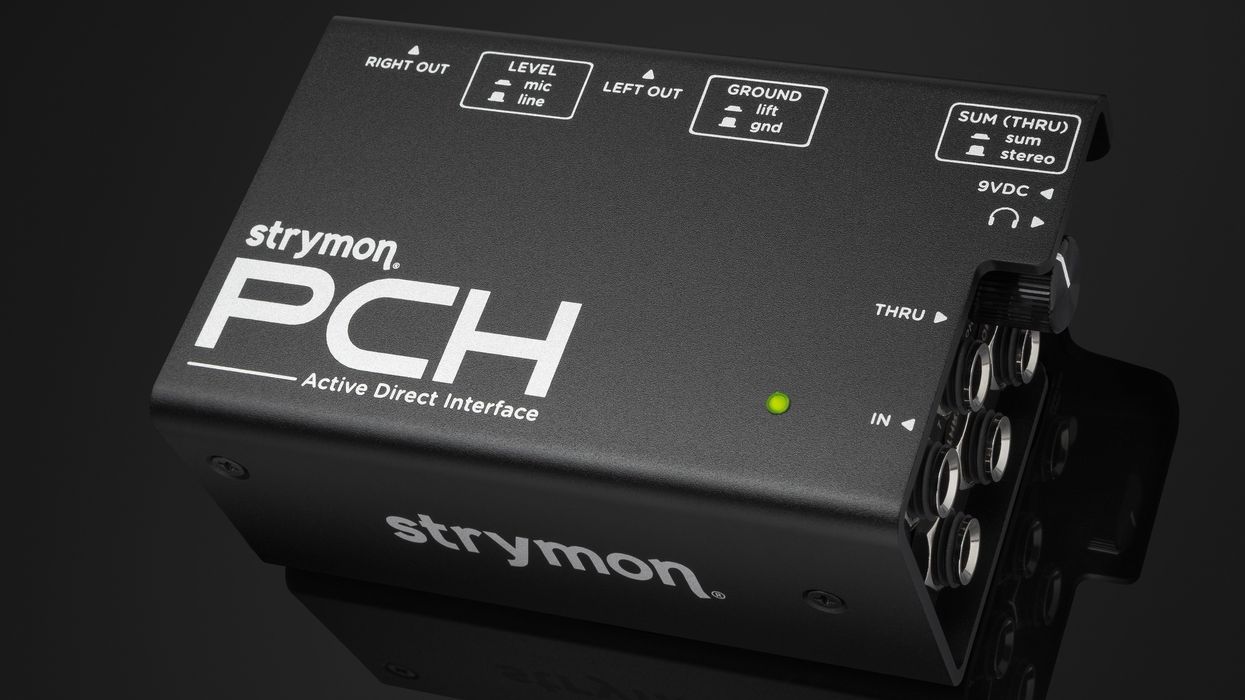
Strymon Engineering has introduced the new PCH Stereo Active Direct Interface, an advanced stereo direct box with a built-in headphone amplifier.
Featuring impressive specs that out-perform DIs anywhere near its price range, PCH also has a unique feature expected to delight pedalboard users: a powerful built-in headphone amp, loud and clean enough to drive even high impedance headphones.
Now you can rest easy knowing that the sound of your pedalboard won’t change even a little when passing through PCH, and the headphone amp means you won’t have to ask anyone how you sound. You’ll know.
PCH makes it easy to monitor or practice while listening to the sound of your entire rig or pedalboard in full stereo. No matter what instrument or style of music you play, if you need to connect unbalanced outputs to a PA, recording interface or flat response speaker system, PCH is the ultimate choice for an absolutely transparent stereo direct interface - and it’s the only one that you can listen to locally via the stereo headphone amp.
Housed in a battle-ready 3mm extruded aluminum chassis, PCH requires 9VDC power, which it converts internally via a custom single-channel Ojai power supply to 24VDC. That extra voltage and high current renders the interface nearly un-clippable, and allows it to achieve a max signal-to-noise ratio of 135db, a hyper-flat frequency response of +/- 0.25db from 10Hz to 80 KHz, and gives the headphone amplifier enough power to cleanly drive even 600 ohm headphones without distortion.
PCH features include:
• Two channel design - use in stereo or dual mono, whichever fits your setup
• Runs on 9VDC - internally converted to 24V to be virtually unclippable
• Stereo headphone amplifier powerful enough to drive high impedance headphones
• Switchable Mic/Line level operation for the XLR outputs
• Defeatable ground lift for the XLR outputs
• Defeatable Sum for the Thru outputs
• Runs off of a modified internal mini Ojai power supply for ultimate performance
• Extremely low THD (Total Harmonic Distortion)
• Bulletproof construction that will stand up to the abuse of the road
“As the music world continues to embrace quiet stage volumes, instrumentalists increasingly turn to amp-less live rigs to achieve good tones at low volumes”, said Sean Halley, Strymon’s Head of Marketing. “Unfortunately this creates problems for players trying to hear their entire pedalboard when they’re anywhere else but onstage. With a PCH at the end of your signal chain, you get a pristine direct interface and a killer built-in headphone amp to make sure that what you’re sending to the PA or recording rig is exactly what you intend to - and it makes silent practicing a joy.”
Gregg Stock, Strymon co-founder and analog circuit guru adds “while we’re more recognized for our DSP effects pedals, they wouldn’t sound the way they do if the analog side wasn’t just as advanced. With PCH we’ve brought that analog expertise to a new market, because it doesn’t matter whose pedals are on your board, you need a bulletproof and pristine-sounding DI to interface with the outside world. PCH isn’t just for guitarists, it’s for anyone with a pedalboard.”
The PCH Active Stereo DI is available now directly from Strymon and from dealers worldwide for $279 US.
Wampler Cryptid Review
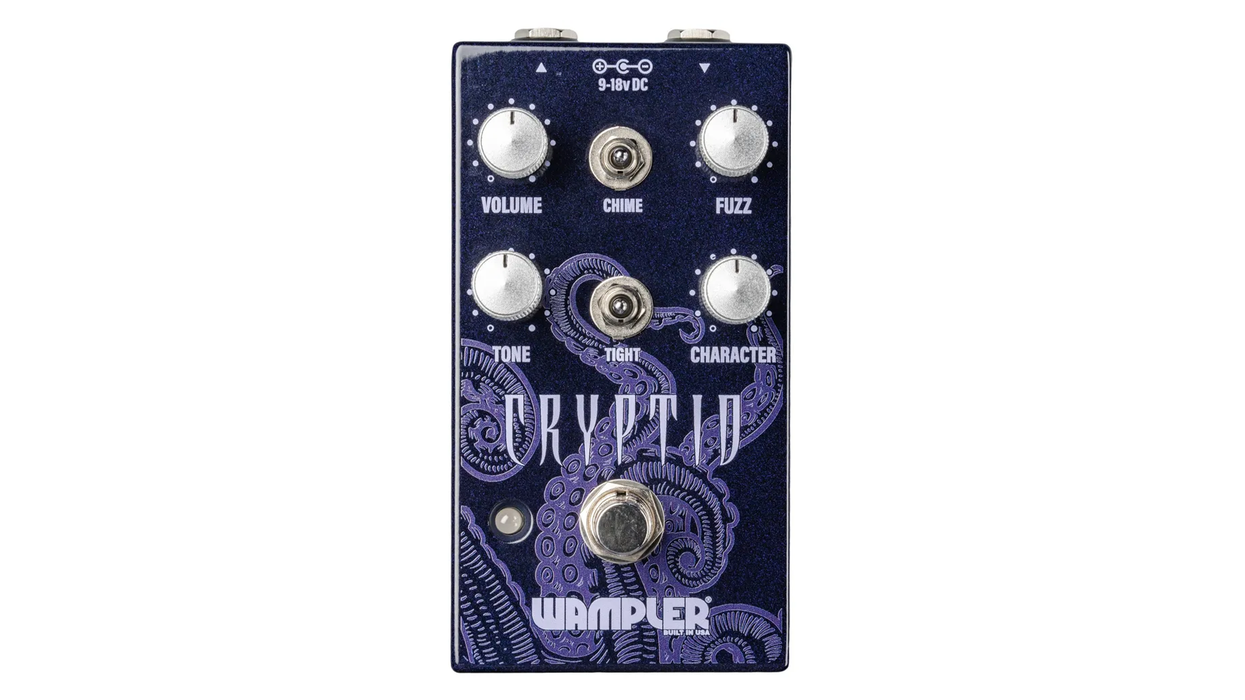
Since hitting the scene in 2007, Wampler has consistently made some of the better overdrive and distortion pedals on the market. Interestingly, though, other than 2013’s Levithan fuzz and its brazen sibling, the Fuzztration, which is a fuzz/octave pedal, Wampler’s product line didn’t feature many fuzz pedals. Since then, Brian Wampler has evolved as a pedal builder, and Wampler’s new Cryptid reflects a unique take on what a fuzz can be—employing a newly designed circuit with NPN and PNP transistors, and FETs.
Wampler has described the Cryptid as a “fuzz for those who don’t like fuzz.” And certainly, it’s a versatile pedal that covers much more sonic ground than conventional fuzzes. In addition to delivering variations on familiar classic Fuzz Face, Tone Bender, and Big Muff sounds, the Cryptid can move into light overdrive or even chiming clean territory.
A Fun House of Fuzz
The Cryptid, despite the implied mystery in its name, is pretty forgiving. You could just set all the knobs at noon and you’d be good to go for any number of fuzz tasks and roles. But this is a fuzz of impressive potential, and every knob and switch—particularly the character knob and the tight and chime switches, and the way they interact—can profoundly reshape the pedal’s performance and feel.
The character knob is a bias control that can shift the mood and responsiveness of the pedal significantly. When the character knob is fully counter-clockwise, the Cryptid is well behaved and focused. As you turn it clockwise, though, things get crazier. Once the character knob is around 2:00 you’ll start to hear sputtering textures that evoke tired, voltage-starved vintage units and more deliberately designed glitch fuzz.
The tight switch lets you regulate how much bass is present in the signal and has a pretty significant impact on the tone. In the down position, it adds in a fair amount of bass. The middle position offers the least bass content and tightens up the sound, which brings out more overdrive-like colors. The up position is the ticket to maximum bass, and even with the fuzz knob set conservatively the Cryptid really is explosive and massive.
The chime switch adds high end. The down position gives a little bit of chime, the middle position is relatively chimeless and has a darker quality, and the up position yields the brightest sounds. The less fuzz you apply to the signal, the more noticeable the chime effect will be. With the fuzz knob all the way counter-clockwise and the chime control switch in the up position, you get delicious, pronounced near-clean tones that fit the bill for Hendrix double stops and Stevie Ray Vaughn blues escapades.
Brian Wampler’s ambitions in putting together the Cryptid—essentially encapsulating the character and tonalities associated with Big Muffs, Tone Benders, and Fuzz Faces, while leaving room for airy, cleaner tones and picking dynamics—were far-reaching. But there is ample evidence that he achieved his aims. Cryptid may not serve many purists searching for classic clone sounds, but it offers the chance to create more original sounds that have all the fire of those classics, and more polite tones to boot.
From Metal Crunch to Country Clean: The Rise of Revv Amps
John Bohlinger sits down with Revv Amps’ cofounder Derek Eastveld to trace the company’s journey from basement builds to pedal boom. And while their Generator Series fire-breathing amps and pedals started its ascent finding homes with rockers The Pretty Reckless & A Day to Remember, Eastveld explains that it might be their clean, versatile Dynamis Series gear that's making the Canadian brand a preference for players and producers in Nashville.
Ella Feingold and Charlie Hunter: A Rhythmic Symposium
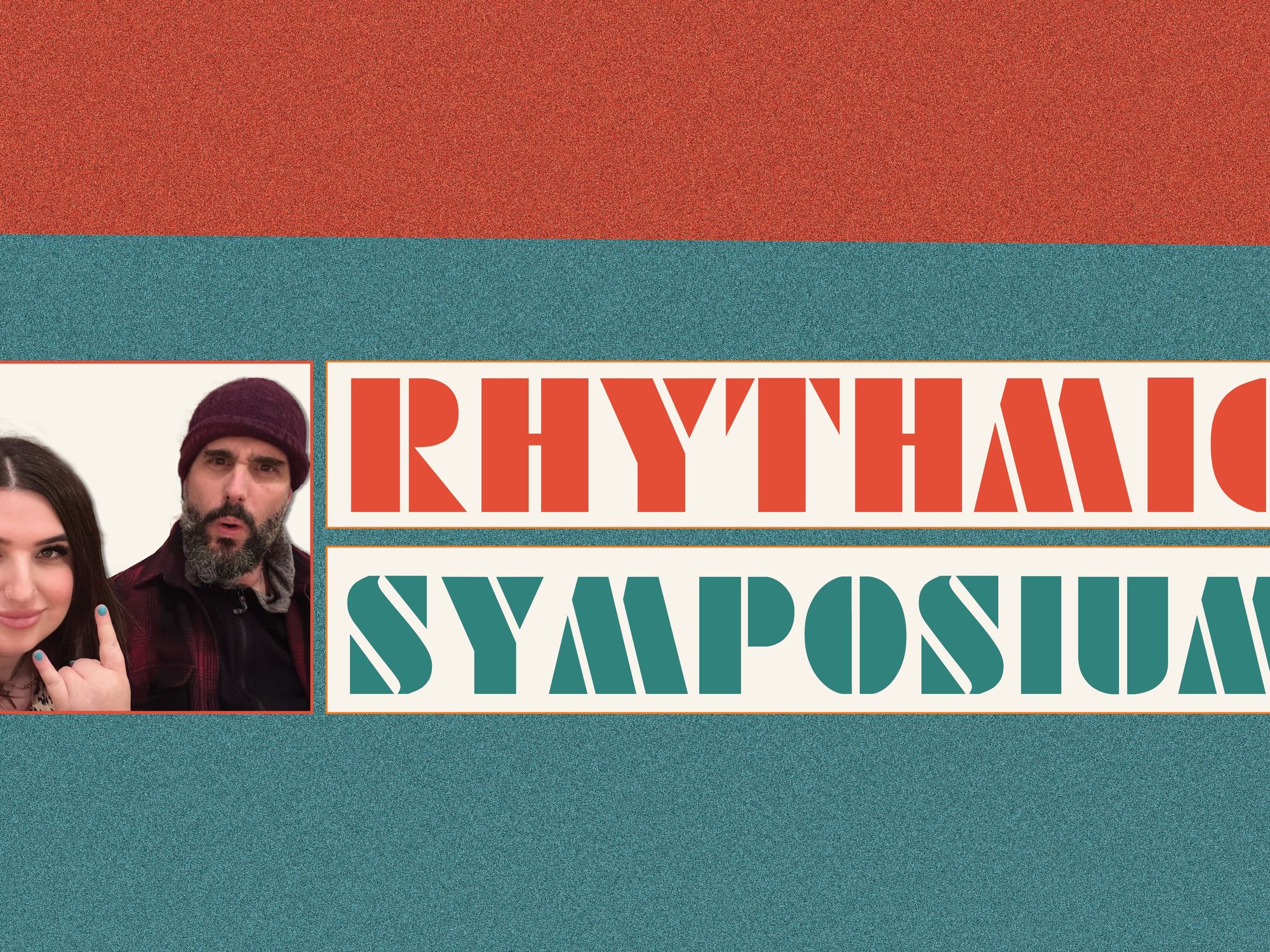
When it comes to rhythm guitar, there are acknowledged masters—artists like Jimmy Nolen, Catfish Collins, Wah Wah Watson, Curtis Mayfield—whose work deserves deep analysis and interpretation. But the discourse on each and every one of these players is sadly thin. That’s because rhythm—especially when it’s funky—is ineffable, and it’s much easier to discuss licks, riffs, melodies, or gear than it is to talk about the give-and-take nuances that make your body want to move when you hear a song. Like Icarus and the sun, if we try to describe a groove too closely we’re setting up our demise. In the attempt to convey those truly human elements of musical performance, we not only fail, but risk rendering ourselves … unfunky.
YouTube
It’s not just words that fall short—musical notation can’t quite capture a groove either. Though it does well at communicating a composer’s intended notes and rhythms, transcribing the intricacies of feel is a task that often overcomplicates something so intrinsic to human nature to the point of illegibility. In learning from the greats of funk, soul, and r&b guitar, we simply have to use our ears as best we can.
“I think we probably share like 60 to 75 percent of our musical DNA. And then the extra stuff that we have adds something to it.” —Charlie Hunter
For some, that only goes so far, so we need visual aides. And that’s how most people—probably—discover Ella Feingold, the Grammy-winning guitarist breaking down the intricacies of those masters of rhythm guitar and many others on Instagram and TikTok, making some of the greatest strides yet in the education—and enjoyment—of funky feel. We’re talking deep, below-the-surface details, like pick attack and note placement—potentially nerd-level stuff that she delivers in a warm, approachable style that makes her videos so engaging and rewatchable. (In fact, if there’s one person I’ve learned the most about guitar from in the last couple of years, it is Ella.)
Feingold’s rhythmic research is backed by a deep resume that spans work as an orchestrator, composer, and producer. As a guitarist, Feingold has been tapped to play alongside an impressive list of leaders that includes Erykah Badu, Silk Sonic, Bootsy Collins, and Jay-Z.
Charlie Hunter is one of many who found Feingold through Instagram. After Hunter—who came up in the ’90s on Blue Note Records, famously wielding a hybrid guitar/bass instrument that set the jazz-funk scene on high alert—scrolled across Feingold’s videos, the two quickly took it to their DMs and established a friendship. Collab talks started soon after. Feingold, who has worked exclusively as a side musician save for a few classical piano pieces, jumped at the opportunity to release a record under her name alongside Hunter, who she lovingly calls “a musical hero.”
The two convened at Pilot Studios in Great Barrington, Massachusetts, with producer Alan Evans—best known as the drummer for Soulive—for a few short days to create Different Strokes for Different Folks, a rhythm symposium of the highest order. It’s a record that’s earnestly old-school by way of a simple approach: capturing a live-off-the-floor two-way conversation between singular instrumentalists. Feingold’s guitar—punchy and percussive but still delicate and detailed—lies on the right side of the stereo field throughout, communing with Hunter’s counterpoint of pulsing bass, which sits near the center, and snare-like guitar chords and knotty riffs on the left. No-frills drums, added by Hunter, pull together the sound, unifying the feel and tying the record to groove masters like Stevie Wonder and Sly Stone—the latter referenced in the album title and its opening track, “There’s Still a Riot Goin’ On.”
“Sly is just my god, my king of dark funk.” —Ella Feingold
Different Strokes for Different Folks is a masterwork of minimal funk: there are no solos, and melodies arise from rhythm itself. It’s an album that draws attention to the finer details of rhythm guitar, and to the communication between rhythmic elements that are often relegated to background duty. Most importantly, it’s an album that will make you feel something.
We got together with Feingold and Hunter to talk rhythm, recording, and the art of musical conversation.
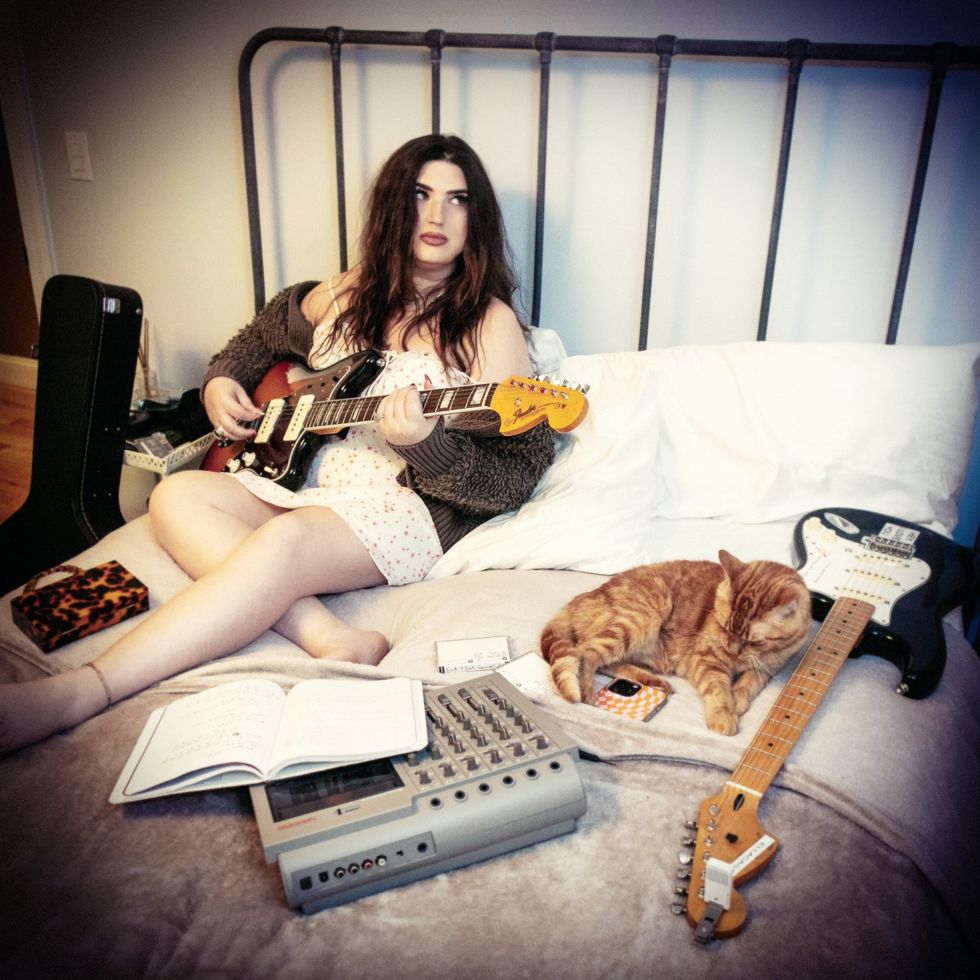
After first meeting on Instagram, what was the catalyst for making the record happen, and how did it come together?
Ella Feingold: I’ve always been a fan of Charlie’s, obviously. Eventually, it led to just talking all the time, about rhythm and all the stuff we love that doesn’t really get discussed a lot. We had a lot in common, and at some point, he’s like, “Yeah, we should make a record together…” which kind of terrified me.
Charlie Hunter: I think we probably share like 60 to 75 percent music DNA. And then the extra stuff that we have adds something to it. I have all this really old knowledge that nobody cares about, like 1920s stuff. And then I always tell people, “You want to know about this one Motown recording from 1968?” Call Ella, because she’s going to know exactly who played on that and exactly every part.
Feingold: We knew we wanted to do a record together. But in terms of the drumming, we had talked about everything from programming an MPC to just having a funk box—a Rhythm King, a Rhythm Ace—to getting drummers. We had talked to Steve Jordan, and Steve was like, “I’m down.” We had talked to Questlove, Questlove was down. And I know this sounds like the douchiest thing in the world to say—because to have musicians like that that are interested in working with us is the grandest honor—Charlie and I, we just wanted the conversation to be between the two of us. We wanted the rhythm to be this mantra that feels good, that moves you to the conversation we’re having, but that’s not the forefront of the conversation.
So it started with us going in, knowing that the rhythm is going to come from him and I, but not exactly sure how. And then with me programming a little bit with the MPC and playing along. Then Charlie replaced everything and killed it on drums. So Charlie’s the drummer on the record. And what I think is cool about that is we wanted it kind of like … when Sly Stone plays drums, and when Stevie Wonder plays drums, or when Lenny Kravitz, whoever, like an artist that plays their own music, does the drum part, it’s going to be exactly what it needs to be and nothing else, with no other filler, no other musicianship, no “look what I can do.” It’s going to be exactly what needs to be there. And that’s exactly what Charlie did.
Hunter: Because I don’t take pride in my drumming, we wanted it to just be as basic as possible.

Ella, there are so many songs you talk about on your social media that I’ve heard a million times, but you’ll show how a part goes and then I’ll hear it so differently. It blows my mind. You have such a good ear for really fine details, and I know a lot of people feel that way.
Feingold: I feel like I get too much credit. A lot of that stuff just comes from what I can’t do—meaning I don’t really solo, I don’t know modes, I don’t really know a lot of scales. There’s so much I don’t know. My ear just goes to the place that makes my ear happy.
I think some of it has come from being on the road in the early 2000s, when there were no stems, no stem-making software, there wasn’t really social media. You had to learn a show from a rehearsal CD or an MP3 and had to pick out guitar parts. You really had to do this kind of deep listening to try and hear stuff.
“If you have a good feel and something to say and a lived experience, you got this.”—Ella Feingold
There are two references to Sly Stone on the album—the title is a lyric from “Everyday People,” and the song “There’s Still a Riot Goin’ On” is a hat-tip to Sly’s 1971 record.
Hunter: That’s Ella’s department. She is a Sly-o-phile.
Feingold: Sly is just my god, my king of dark funk. You obviously have George Clinton and James Brown, but something about Sly, for me, it’s just the greasiest, most raw, tasteful … it’s something that just hits me in the chest. A lot of my musical aesthetic was from Sly and from him playing all the instruments. And then all the music I adore—D’Angelo and J Dilla and some Prince—it all comes from Sly.
If I can get political, I’m a trans woman, and we did that album in February, a month after the inauguration, after Trump was going after trans people, taking away life-saving medicine and hormones and fucking with our passports and all kinds of stuff. And I felt a lot of turmoil. So going into the record, it just felt like there was a riot going on—externally in the world and internally within. And I just wanted some of that to be reflected in the conversation. Not just because I love Sly and the Sly references. Certainly “different strokes for different folks” came out of the lyrics, but it’s cool because “different strokes” can also be referring to Charlie’s stroke and my stroke on the instrument, and there’s also the Muhammad Ali reference—knocking people the fuck out.
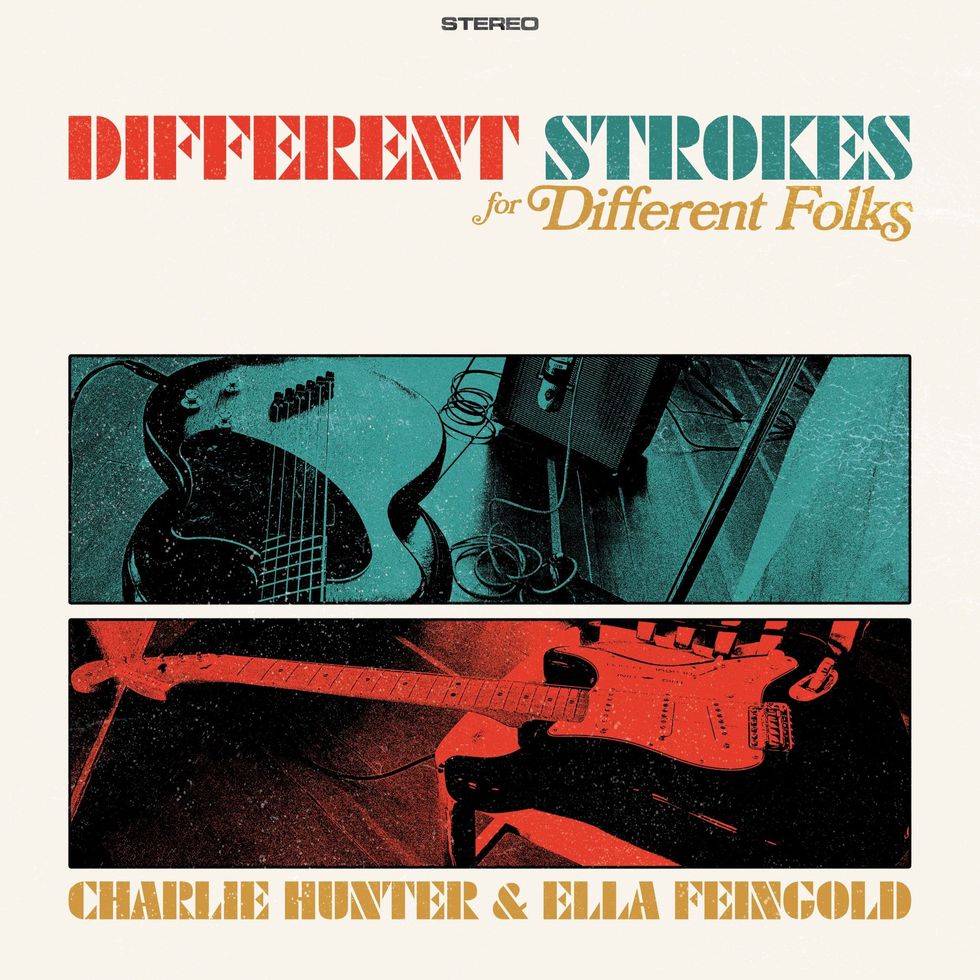
Tell me about the guitars you used on the record, and the tunings.
Feingold: I used a Mexican Strat in inverted tuning—it’s E–A–D–G–B–E, but it’s high to low, not low to high, so familiar voicings become distant relatives.
Where did the inverted tuning come from?
Feingold: From my buddy Blake Mills [who learned it from Chris Weisman]. I even have the text message where he said, “I’m about to change your life.” For me, the appeal was it gave me the rhythm sound I wanted in terms of attacking the high strings first. And the tuning felt a little familiar, because it’s related to standard. Although anything above a triad, the overtone series sort of gets put on its head—all the color tones are on the low strings and all the roots and thirds are on the high strings. But it opened up this whole new world of harmony that was like Claus Ogerman harmony—close position stuff you’d hear Nat King Cole or George Shearing play. What I love is it’s sort of similar to Charlie’s whole journey, which he took long before I did, of, “What does this thing want to be?” And then finding a sound with it.
“The first time we played, I was like, ‘This sounds like a gigantic lawnmower guitar that can take buildings down.’” —Charlie Hunter
Hunter: I think there’s also something really special that happens because of Ella’s inverted tuning and the fact that it’s basically in E, while my hybrid tuning is basically an F. Every tune, we each have a different set of open notes and a different overtone series that makes the instruments do this really cool shimmery thing together. The first time we played, I heard that and I was like, “This is dope. This sounds like a gigantic lawnmower guitar that can take buildings down. All right, let’s go do this.”
Charlie, your journey with your instrument has been well documented at this point, but catch us up a little bit.
Hunter: I started on this 8-string guitar, and that was really a bad idea. And I made a bunch of records on it. I just was like, “Hey, Ralph Novak [of Novax Guitars], can you make this? I have an idea. Could be cool.” Never thinking this was going to be my career. Before I knew it, I had a deal with Blue Note. And then I'm like, “My god, I can’t really do this very well. It’s so hard. What am I doing?” It took me years to figure out, “What does this instrument want to do?”
So I hooked up with Hybrid Guitars and I settled on this thing I’m calling the Big 6. What this instrument does best is really more like a drum set, where you have bass and guitar and it’s all about the counterpoint. It has an extra long scale—the lowest string is 31 inches and the highest is 28.
I have it tuned F, Bb, Eb—which are the lower three strings of a bass, up a half-step—which sends me into a hell of transposition, but sounds so much better than E. And the guitar [side] is Bb, Eb, Ab, which is essentially A, D, G up a half-step.
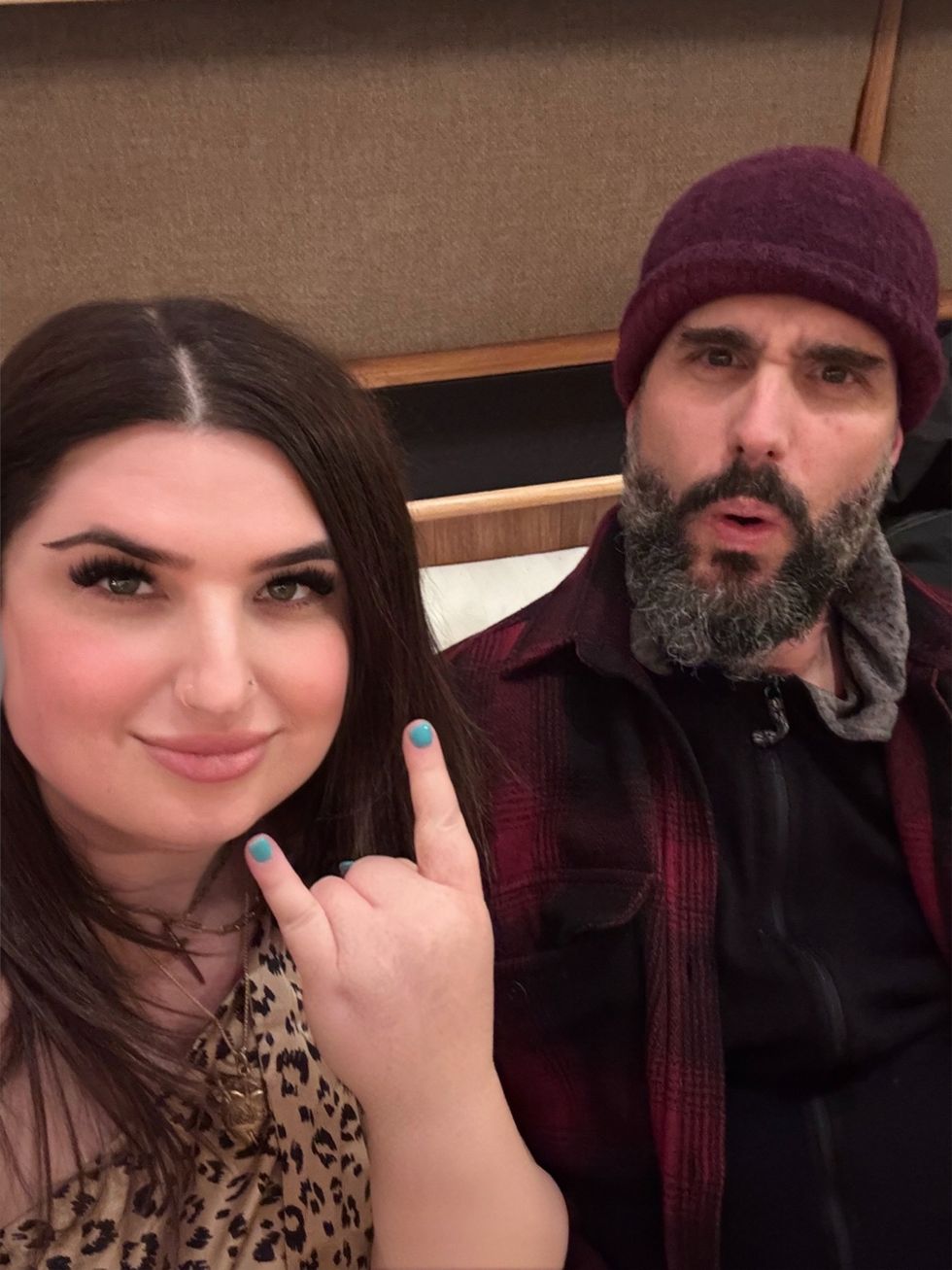
Ella Feingold’s Gear
Guitar
Fender Jimi Hendrix Stratocaster with Fender Custom Shop Fat ’60s pickups and inverted tuning
Amp
1968 Fender Princeton Reverb
Effects
Ensoniq ASR-10 used for envelope filter
Strings and Picks
La Bella inverted tuning custom signature set (.046 E; .032 B; .017 G; .026 D; .016 A; .011 E)
D'Addario Ukulele 3.0 mm
Charlie Hunter's GearGuitarHybrid Guitars Hybrid 6 (aka Big 6)AmpTwo-Rock Studio SignatureAmpeg B-15Acme Audio Motown DIEffectsSurfyBear Compact DeluxeStringsThomastik-Infeld Jazz Flat Wound (bass side)Thomastik-Infeld Pure Nickel Round Wound (guitar side)
What was the biggest revelation that came from working together?
Hunter: For me, it’s just that we have a great time playing together, and I just learned a ton, you know? And if I can take that away from any situation, it’s a win.
Feingold: The gift of working with Charlie is it gave me the confidence to make my own music. Because I’ve spent my entire career helping other people with their music, playing on their records or producing. I’ve never invested in my own music because I always thought you have to make your own, like, Pet Sounds or Sgt. Pepper’s—you’re going to be working, writing for years. And it was like, we went in there, we had some ideas over a couple of months, and it turned into over an hour of music.
And it just was like, “Wow, I’m overthinking this stuff like crazy.” If you have a good feel and something to say and a lived experience, you got this. That was kind of an unexpected gift. After Charlie and I finished mixing the record, I bought a four-track and I made an EP. I was really inspired by just being around Charlie.
So if you have something to say in the moment, that’s it. That’s the most important thing.
Dunlop Releases Special Edition of Randy Rhoads MXR® Distortion+
Last year, we released the MXR Randy Rhoads Distortion+, a pedal that celebrates Randy Rhoads’ revolutionary contribution to rock ’n’ roll guitar playing. The original MXR Distortion+ was a key part of his riveting sound, and our MXR engineers worked directly with sister Kathy Rhoads to ensure that this tribute would be equipped with all the components necessary to accurately recreate that sonic signature. The first run sold out quickly, leaving fans clamoring for another chance at those iconic tones. And now, it’s back.
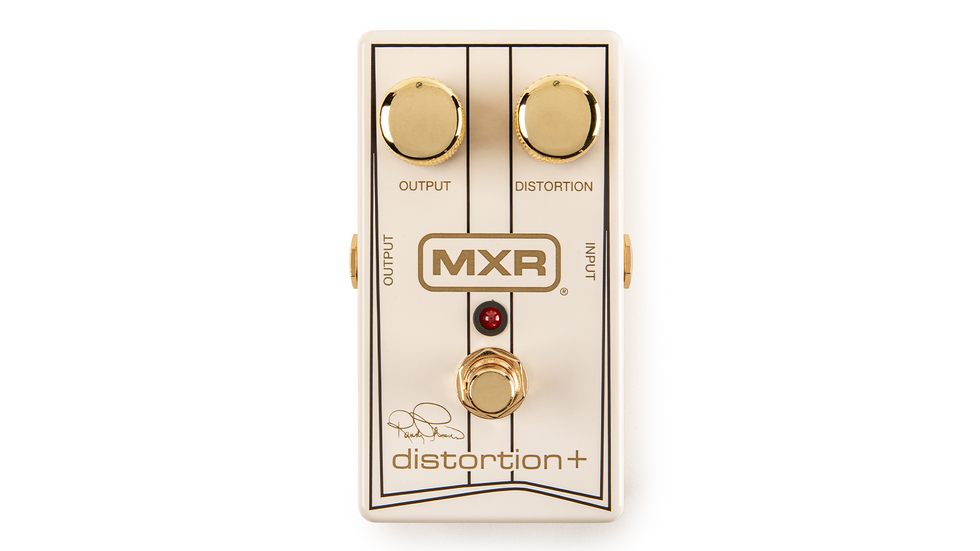
The Randy Rhoads MXR Special Edition Distortion+ features a clean white finish with pinstripe accents, inspired by the iconic Flying V-style guitar that Randy designed after flying on a famous supersonic airliner while touring with Ozzy Osbourne.
Randy Rhoads MXR Special Edition Distortion+ highlights:
- A tribute to the monumental legacy of Randy Rhoads
- Recreates the raw, overdriven tones heard on his most beloved hits
- Painstakingly spec'd from Randy's own MXR Distortion+
- Designed with the direct involvement of sister Kathy Rhoads
- Custom finish inspired by his supersonic V-inspired guitar
- Includes exclusive collector's booklet
Availability
The Randy Rhoads MXR Special Edition Distortion+ is available now at $189.99 street/$271.41 MSRP from your favorite retailer.
SOMA Harvezi Hazze Review
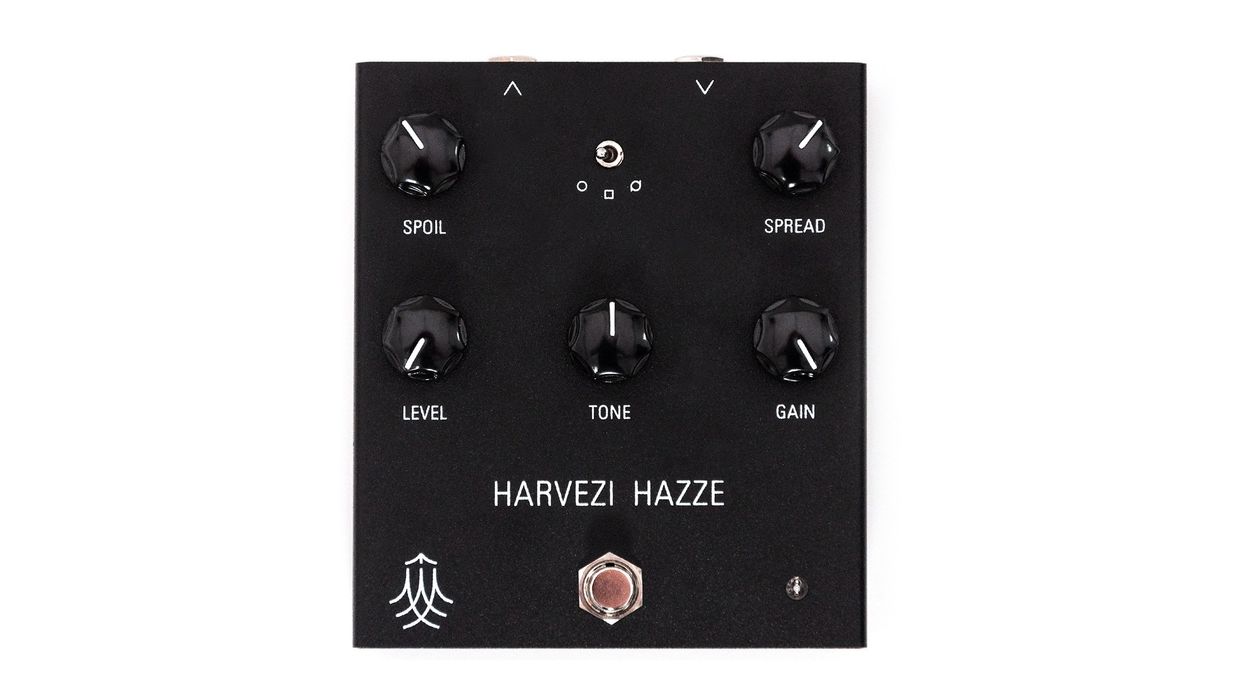
Any distortion pedal with white text on a matte-black finish is going to draw comparisons to Pro Co’s beloved rodent, the RAT, but SOMA Laboratory’s Harvezi Hazze offers a much more versatile brand of distortion. It’s a smartly designed, do-it-all transistor distortion and waveshaper—a function that changes waveforms from, for instance, sine, to square, to triangle, altering the output significantly. Together, the Harvezi Hazze’s circuit and interactive controls summon many unusual tones that go beyond simple distortion.
Spoil Sport
Harvezi Hazze’s three lower knobs—level, tone, and gain—need little description. Up top, though, there’s a switch for selecting from soft-clipping, hard-clipping, or “total feedback mode,” as well as knobs labeled spoil and spread. Spoil sets the amplitude threshold at which the waveshape change takes place, and spread sets the intensity. These two knobs, and the interplay between them, are the beating heart of Harvezi Hazze, and the key to unlocking the most unusual dirt.
A suite of six switches on the side of the enclosure greatly expands the Harvezi Hazze’s palette. From first to last, they activate the tone circuit, boost bass frequencies, change how the tone knob functions, change the central frequency of the tone sweep, cut highs, and engage a preset compressor situated just after the input.
Jams from Georgia
The Harvezi Hazze’s wavehaper is based around unijunction transistors sourced from e-waste bins at flea markets in Tbilisi, the capital of the nation of Georgia. (The pedal’s Georgian name roughly translates to “a fault on the transmission line” or “signal jamming.”) The obscure transistors help the Harvezi Hazze cover tones from gentle distortion mixed with clean signal to warped, sputtering mayhem. In my testing, I discovered so many fascinating, musically pleasing sounds that I was stumped at how they all fit into one dirt pedal. The engineers at SOMA turned an impressive magic trick with this one.
At times when I wanted heavier and dirtier sounds from the Harvezi Hazze I found that tweaking the spoil and spread settings, while altering with the tone knob, can squeeze much more aggressive and volatile sounds from the pedal. There is one drawback to all this versatility: Because the controls are all so interactive, small adjustments can leave you wondering where one sound went and how you arrived at the latest one, and the lack of presets means you’ll be taking lots of photos of your settings if you want to revisit them.
The Verdict
$336 for a distortion pedal is a big ask, but in terms of flexibility and range of possible sounds, Harvezi Hazze is up there with the most deeply featured distortion units on the market, and there are boutique offerings in this price bracket that deliver a tenth of what this pedal can accomplish. In the studio, you could track 10 different guitar parts with totally unique sonic fingerprints, all with the Harvezi Hazze. For the right players and producers, this pedal could be a one-stop tone shop, and a studio staple.
Introducing the LYRA: Two Legends. One Amplifier.
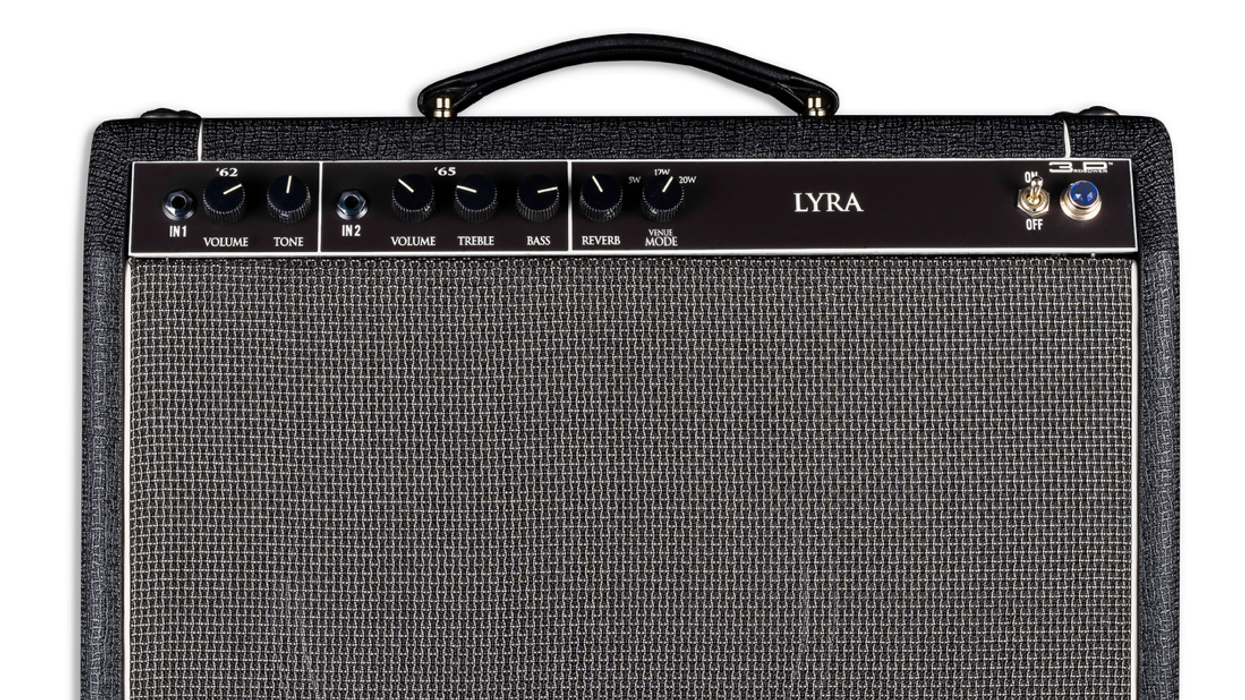
3RD POWER unveils the LYRA, a handcrafted tube amplifier that unites the voices of two of the most iconic amps ever made—the 1962 Deluxe and the 1965 Deluxe—in a single, elegantly designed package available in head format as well as 112 combo.
Built for players who demand authentic tone and uncompromising versatility, the LYRA allows guitarists to step seamlessly between the warm, raw character of the early ‘60s and the refined clarity of the mid-’60s.
With meticulous attention to detail, premium components, and vintage-inspired craftsmanship, this amp captures the soul of two eras while offering modern reliability and transportability. In use, each signal path is pure tube, focussed and effortless. Plug into either channel, or access them both with your favorite AB-Y pedal, and it feels alive - responsive to every touch, every note, as well as every silence. Tube driven spring reverb and our patented VenueMode attenuator are built in and round out the features.
"The LYRA is about honoring history while inspiring new sounds," says amp designer, Dylana Scott. “On stage or in the studio, it’s like having two timeless classics by your side,—ready at the flick of a switch."
The LYRA is now available in limited release.
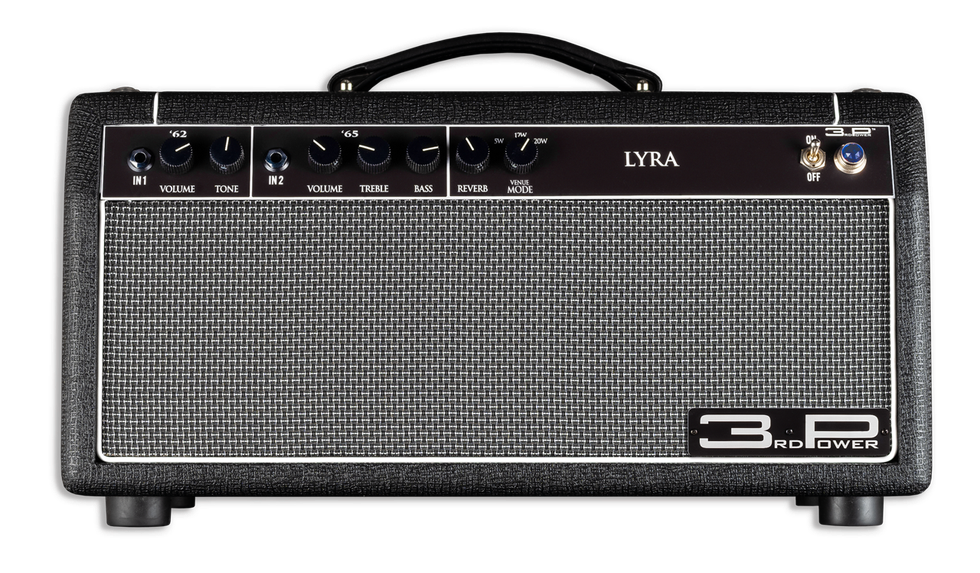
LYRA Features:
- Head or 112 Combo Versions Available
- ’62 DELUXE Voice on Channel One
- ’65 DELUXE Voice on Channel Two
- Tube driven Spring Reverb on board
- Dual 6V6 Power Tubes
- Patented VenueMode™ Built-in Attenuator (20W/12W/5W modes)
- Custom Wound USA-made Power & Output Transformers by Heyboer
- Hand-wired and Hand Built in Minneapolis, MN
- Limited Lifetime Warranty
Pricing for LYRA is around $2799 (head version) and $3299 (112 combo). For more information, please visit www.3rdPower.com.
Tonewood Teardown: How Good Can a Cheap Guitar Sound?
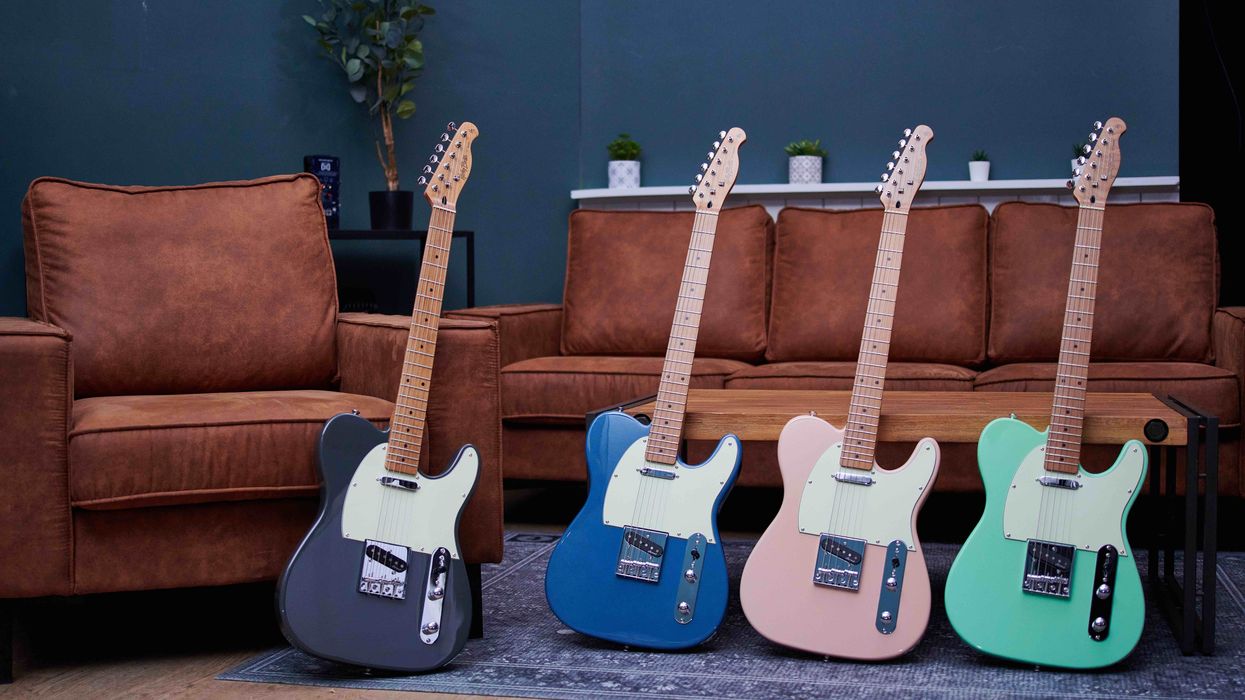
Hello, and welcome back to Mod Garage. This month, we will start our custom-shop experiment with a very cheap electric guitar and see how far we can push it, customizing each and every little detail to see if the wood is really important regarding the amplified tone of an electric guitar.
Basically, we will be putting high-quality parts into an extremely cheap guitar to see what will happen. The idea behind it is very simple: If the wood plays a major role in the amplified tone of an electric guitar, our cheap guinea pig can’t sound any good, no matter what we do. However, if it’s really all about the pickups, electronics, internal wires, guitar cable, strings, and, of course, the individual playing style, the cheap guitar has the potential to sound fantastic. (Another interesting experiment would be to put cheap pickups, electronics, wires, etcetera, into a high-end custom shop electric guitar, and see what happens!)
“This is the perfect guinea pig for our experiment because it sports a lot of features that are considered ‘bad’ for the tone of a guitar.”
You may remember the thesis from the last issue: The more solid an electric guitar is built, the less influence its primary structure has on the amplified tone. So to get this challenge started, I decided to use a Telecaster-style guitar, thanks to its very solid construction. I got a Harley Benton TE-62CC model from Thomann for $148 including shipping. It was delivered in a nice vintage seafoam green color. That’s a complete guitar for less than the price of a good pickup set, so what can we expect from it? It was important for me that the guitar wasn’t pre-selected, so I asked for a randomly picked instrument out of the pile, with the stipulation to not open the box and send it directly to someone else rather than to me so you can be sure I had no chance to do any work on this guitar. A big shout-out to Benedikt from Harley Benton to make all this happen.
The guitar was shipped directly to my friend and colleague Haiko Heinz, who is not only a professional guitarist and teacher but also a renowned gear tester and columnist for the German online mag Bonedo. Haiko runs his own gear-review channel and has made countless gear-testing videos, so you can be sure that over the years he’s had his hands on virtually everything with 6 strings. I asked Haiko if he would make a “before video” of the guitar and he agreed; you can watch Haiko playing the guitar here. (After my work is done, I will ship the guitar back to Haiko and he will make another video to compare it with the stock factory condition.)

After finishing the first video, Haiko sent the guitar to me, and I have to say that, considering the price, I was really impressed with the quality. It’s a standard vintage-flavored Telecaster, and the plan is to completely take it apart down to the last screw, analyse each and every little detail, and transform it into a much better guitar in terms of playability, comfortability, longevity, appearance, and, of course, tone. My goal is to keep the budget under $500, including the guitar, so I’ll be using a mix of new and used parts for our remaining $352. Let’s see how far we can get with this.
The entire procedure is not set in stone. It’s just one possible way to do such a project, and certainly not the only way. I want to keep it as transparent and easy as possible so you can follow along, step-by-step, if you have a guitar you want to spruce up.
So what can we expect from a guitar at this price? We can be sure that we’ll find some flaws and signs of cost-cutting under the high-gloss hood. This is the perfect guinea pig for our experiment because it sports a lot of features that are considered “bad” for the tone of a guitar. Here are the most prominent of them; we will talk about all of these in detail during this series.
• The body is made out of basswood, which is not a classic tonewood.
• The body is made out of multiple pieces of wood.
• The body is not nitro lacquered but has an ultra-thick polyurethane finish, which we all know is killing tone because the wood of the guitar can’t breathe and resonate freely.
• The “1-piece” maple neck is not one piece and has a glued-on maple fretboard, which is not vintage correct, and lessens high-end and attack.
• The guitar is really lightweight so it’s not very loud and doesn’t sustain well.
• It comes with thin strings which have less sustain and thinner tone.
We can’t change the primary construction of the guitar (i.e. the wood used for its body and neck), so through the course of our mods we’ll see how much these things matter to a guitar’s tone. I’ll even install some lighter-gauge strings to really start from the lowest possible point tonewise—at least, according to Common Internet Guitar Knowledge (CIGK).
After playing the guitar for a while and thinking about what to do with it, I decided to transform it into a single-pickup Esquire-style model, because less is often more. We will talk about the differences between a 2-pickup Telecaster and a single-pickup Esquire in detail and you will see it’s not the same tonewise.
If you’re following along with one of your own guitars, your exercise for this month is to completely take it apart. I will do the same with my Harley Benton so we have the same starting point.
Next month, we will start to work on the guitar, defining what to do and making some plans on how to proceed. The custom-shop game is open now, so stay tuned!
Until then ... keep on modding!
BEST of Rig Rundown: Psych-Rock Pedalboards
Experience a sprawling collection of fuzz, delay, and modulation pedals that fuel massive walls of Pscyh-Rock sound. From vintage fuzz faces to boutique builds and custom creations, look back at classic Rig Rundowns from The Flaming Lips, All Them Witches, Elder, King Gizzard & The Lizard Wizard, and more.
New BzzzzKill Device Solves Stratocaster 60Hz Hum Problem
The newly launched company BzzzzKill has introduced its debut product: a specially designed coil that drastically reduces hum in Stratocaster-style guitars.
BzzzzKill solves a problem that has plagued Strat players for more than 70 years: single-coil pickup noise. The new BzzzzKill hum reduction device virtually eliminates Stratocaster 60 cycle hum without noticeable tone loss or permanent modifications to your guitar and its pickups.
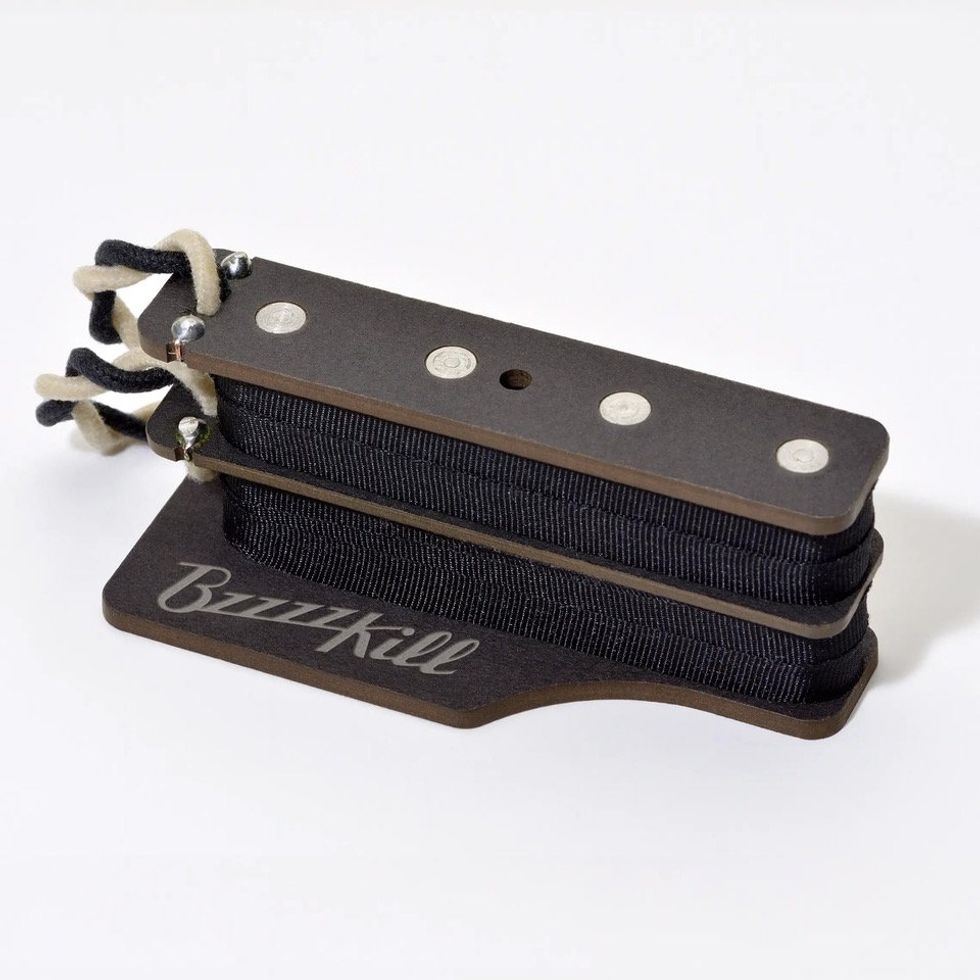
Unlike other solutions that require pickup replacements, permanent alterations, or external power sources, BzzzzKill employs a meticulously engineered passive dummy coil that installs inside your guitar’s control cavity without drilling.
On most Strat-style guitars, the installation process is straightforward and easily reversible, with no need for batteries, routing, or new pickups. Simply remove your pickguard, place the BzzzzKill coil next to the pickup selector switch, solder its wires to a few existing solder connections, and you'll immediately hear a dramatic Improvement. Single-coil 60 Hz hum is virtually gone and your tone is retained.
BzzzzKill’s design finds the optimum balance between hum reduction and tone preservation. It’s currently available in two models. A Dual Layer model is specifically optimized for Stratocasters with reverse-wound/reverse-polarity (RWRP) middle coils. A Single Layer model is designed for vintage-style SSS (single-single-single) pickup configurations.
The innovative solution operates as a passive device requiring no batteries or maintenance, working in all pickup switch positions and remaining compatible with effects chains. The device maintains the guitar’s original dynamic range and low-end response while virtually eliminating hum at all gain levels except maximum gain settings, where only minimal hum remains.
BzzzzKill is the culmination of decades of research and development by inventor Richard Moreton of RSM Custom Guitar Works. “I created over 200 prototypes in perfecting the BzzzzKill, mostly to solve my own quest for great tone and the ideal combination of hum reduction, and tone preservation,” says Moreton. “What started as a personal mission to get rid of the buzz in my own Strats became an obsession to create something that didn’t exist — one-and-done noise reduction without the compromises other solutions demand.”
Current BzzzzKill models sell for $199 USD for both the Single Layer and Dual Layer configurations. The company plans to expand to Telecaster and other single-coil models in the future. For more information visit www.bzzzzkill.com.
Boss RT-2 Rotary Ensemble Review
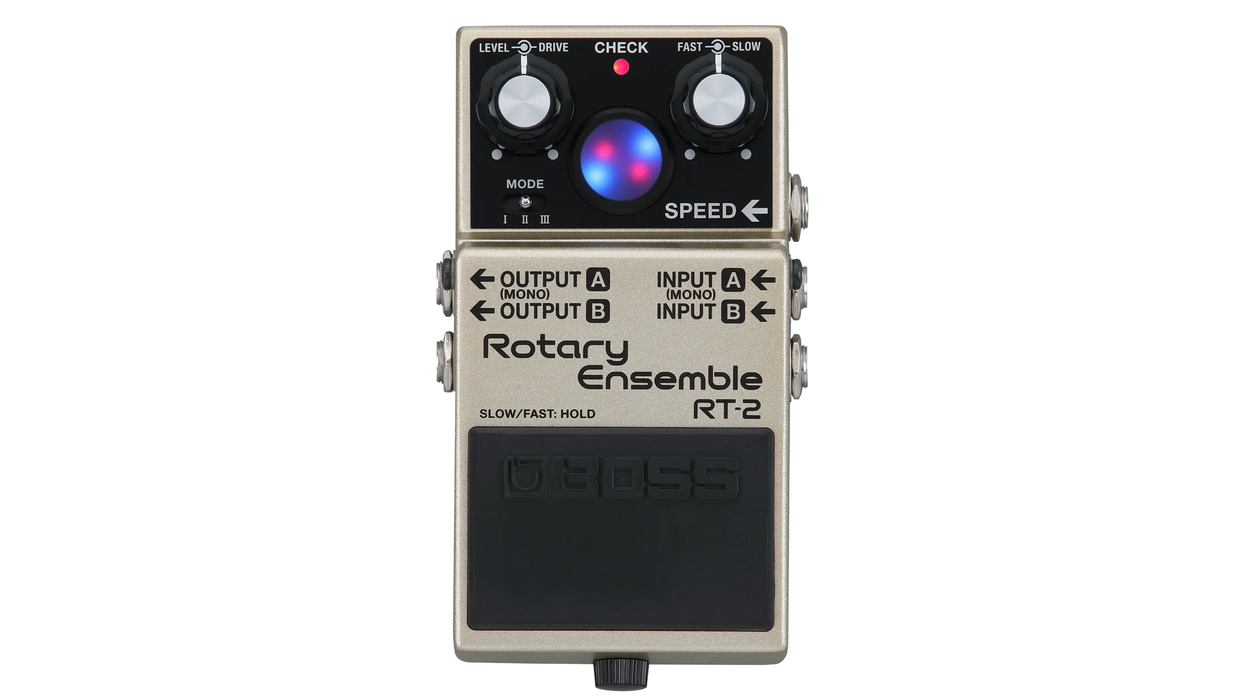
Ours is a frantically paced world. So, I quite like instruments and effects that slow my roll. Delays, reverb, and tremolo all do the trick nicely. But rotary-speaker-type effects can be every bit as good at slowing frantic, frenzied picking to a molasses pace.
Whether a rotary-style pedal “spins” at a slow rate or a fast one … it’s all a lullaby to me. To truly distort time and have a decelerative influence, though, a rotary effect must create a real sense of depth. Boss’ RT-2 Rotary Ensemble possesses this kind of dimensionality in abundance. It’s syrupy and complex. And while it lacks some of the features that distinguish more embellished, contemporary rotary, vibrato, or Uni-Vibe-style pedals, the Boss’ smartly streamlined controls deliver subdued or in-your-face modulations in many shades, with functionality that doesn’t distract.
Ode to Rotation
Though the RT-2 is, in many respects, a more compact riff on the Boss’ RT-20, which was discontinued in 2019, it isn’t as simple as it looks from five paces. The two knobs on the pedal’s face are actually four controls made up of two concentrically stacked dials. Two of the knobs set the speeds you move between when you press and hold the soft-latch pedal. The other two set the effect output level (which is handy for backgrounding or foregrounding the effect) and a drive circuit that approximates tube amp drive in a real rotary speaker. The drive control, though, can also be repurposed as a balance between virtual bass and treble “horns” when you slide a switch on the pedal’s crown. A second switch on the crown selects fast and slow ramp times between two rotary speeds.
A third “mode” switch moves between three distinct effect voicings. The first, in Boss’s description, approximates the frequency response of a Leslie 122. To my ear it is the most open and neutral of the three. Mode II is described as having a wider tonal range more suited to drive and distortion. It’s much more focused in the midrange and slices like a machete when paired with a gain device or overdriven amp. Mode III is flat-out dirty, and while it sounds cool with distortion, it’s useful for achieving radical tone shifts in rigs with fewer effects. A lot of Hendrix and Gilmour fans will spend time here. The footswitch, in addition to functioning as the bypass, and the ramp switch can be reconfigured in different ways. Most notably, it can be used to activate the slowest rate of rotation first, or vice versa.
Sundae Swirl
Though some expensive, dedicated rotary speaker simulators may be better at achieving the mechanically derived, microtonal nuances of a real Leslie or Fender Vibratone, the RT-2 nails the mood and basic richness of the genuine article. The modulation pulses are distinctly hazy around the edges in a way a Uni-Vibe pedal or standard vibrato is not. At the slowest rates, these modulations can serve as a simple thickening agent in a fashion that almost mimics light boost or compression, particularly when the effect level is set to conservative zones. Faster modulations are more overtly rotary-like. Pitch shifts are less binary and bouncy and instead seem to melt into one another. And in a recorded mix with an appropriate sense of room ambience, you’d probably be hard-pressed to discern the RT-2 from a real Leslie.
Though the drive control is effective for adding attitude and color to modulations, I derived a lot more utility and fun from using the control in its balance capacity. The ability to mix the virtual high and bass horns—effectively mimicking the microphone placement and mix emphasis when recording the treble and bass horns on a real Leslie—enables surgical placement of the effect in a mix. But it also helps summon the RT-2’s most natural and realistic rotary tones, and it’s the control I tinkered with most when exploring the pedal’s range.
Accurately simulating a real rotary speaker remains one of the trickier feats in pedal design. Not coincidentally, the best simulators are pretty pricey. And while the RT-2’s $239 price tag can give pause, the pedal’s combination of no-fuss functionality, compact size, and often very delicious, convincing, and ecstatically elastic and animated approximations of a mechanical Leslie make crossing the $200 threshold a much more palatable proposition. And I’d venture that once you are fully immersed in the RT-2’s textures, and the surprisingly numerous, even unconventional, ways they can be applied, this well-executed pedal will pay back the investment many times over.
Alex Lifeson in the Limelight
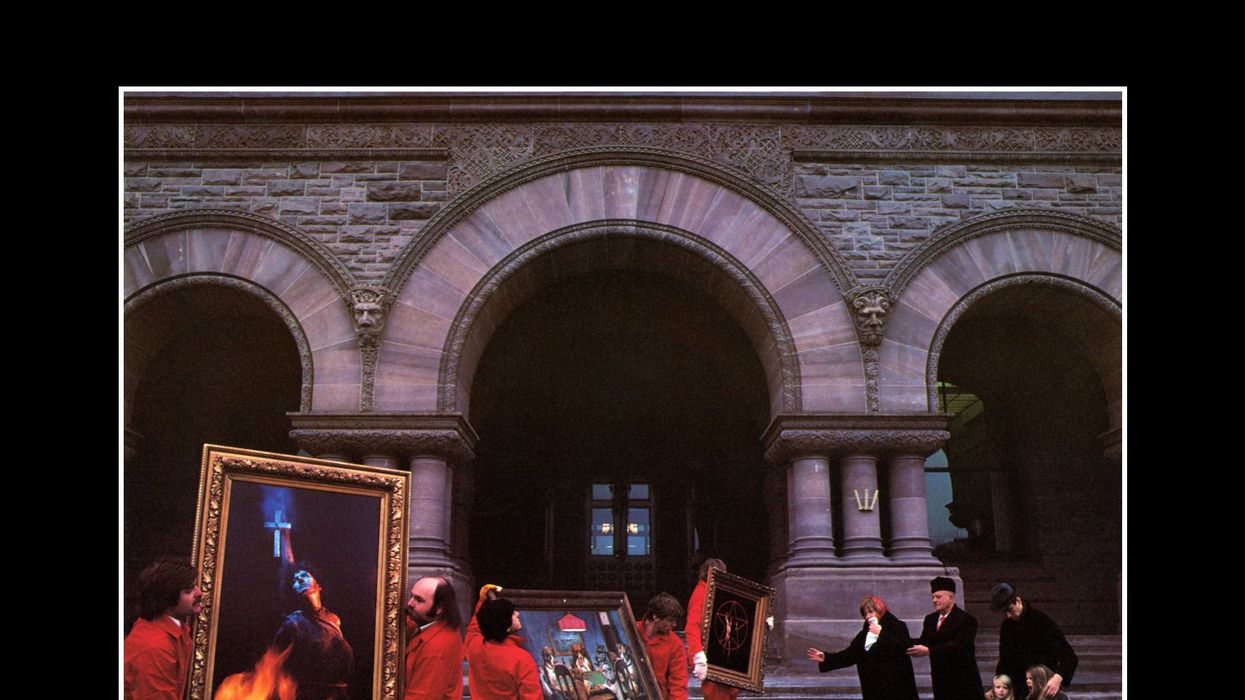
Who could forget Alex Lifeson’s soul-stirring acceptance speech at the band’s 2013 induction to the Rock and Roll Hall of Fame:
Yes, Rush are a “progressive rock band,” with all the weighty importance that it brings, but at their core is a sense of humor that allows them to not take themselves too seriously. The result is that, while their music may be complex at times, overall, it lacks the pretense and self-importance that can permeate bands of the genre.
Along with with late drummer Neil Peart’s masterful drumming and Geddy Lee’s vocals and powerfully melodic bass lines, it is Lifeson’s striking versatility that has made Rush one of rock’s most unique and compelling musical triangles for over 40 years:
Combining vast arrays of chiming chords …
and more, Lifeson’s inspiring creativity and musical savvy quickly become apparent to listeners. Let’s journey through some of the Canadian trio’s most classic songs to see if we can figure out just what makes him tick.
Open Strings Are Our Friends
In the debut episode of Premier Guitar’s Shred With Shifty, affable host and Foo Fighters guitarist Chris Shiflett, together with Lifeson himself, break down the latter’s solo from “Limelight,” off of 1981’s Moving Pictures. It kicks off with a clever use of a simple open B string, as shown in Ex. 1.
Ex. 1
As Lifeson explains, he doesn’t pick the harmonic. Instead, he lightly taps the ringing open string with a fret-hand finger at the indicated fret. (Lifeson uses his index; Shiflett, his middle.) Interestingly, the open B string wends its way through much of the song, including its trance-inducing chorus. Ex. 2 is inspired by this stirring section; note how the open B string acts as a hypnotic drone through all of the chords, a signature Lifeson move.
Ex. 2
You can take many open-position chord forms and experiment with moving them up the neck, while letting any open strings ring. Sure, you’ll inevitably hit some clunkers, but a good rule of thumb is, if the open string is in the key, you’ve got a good chance of finding some magic. Lifeson does just that in the intro to “La Villa Strangiato” from 1978’s epic, Hemispheres, as he positions a standard open G chord up at the 8th fret, creating a unique Cadd2 voicing.
Ex. 3 is along the same lines; note how there are two open strings, D and G, that, when added to this very basic chord form, revitalize it to swirling effect.
Ex. 3
As in the “Limelight” solo, Lifeson cleverly weaves the open B string into his “YYZ” solo, Moving Pictures’ bombastic instrumental. Here, though, he employs it as a pedal point, a re-articulated or sustained note generally played below (or sometimes above) an accompanying melodic figure. Ex. 4 closes out his sinewy solo in grand fashion.
Ex. 4
Only the very first note is picked; the rest are sounded by a series of hammer-ons and pull-offs, which require some fret-hand strength to execute. A great exercise is to take the same figure and move it to other open strings, which is also a fun way to learn your scales horizontally across the neck. Throughout his solo, Lifeson employs B Phrygian dominant mode (B–C–D#–E–F#–G–A), which is simply the 5th mode of E harmonic minor (E–F#–G–A–B–C–D#). Fear not, all this means is that it’s the very same E harmonic minor scale, but here, B acts as the root or tonal center instead of E. Examples 5 and 6 apply this scale to the 1st and 3rd strings, respectively.
Ex. 5
Ex. 6
Familiar Chords in Unfamiliar Places
Just as how Lifeson uses open-position chord shapes up the neck with open strings, he also is adept at taking closed triad shapes (no open strings) and cleverly moving them in similar fashion. His solo in “Subdivisions,” from 1982’s Signals, rises to a climactic end this way, as shown in Ex. 7.
Ex. 7
This familiar “D” shape is one of three triad shapes found on each of the guitar’s sets of three strings. In other words, the same three notes (we’re excluding the open 4th string from the previous example) can be rearranged to find two other inversions along the neck. Let’s use them to play the same “Subdivisions” chord progression, but in different registers of the neck, as in Examples 8 and 9. Note in bar 2 of each how the new shapes lend themselves to different melodic choices and thus, new chord colors.
Ex. 8
Ex. 9
Navigating Odd Spaces
The previous examples contain some interesting rhythms, something for which Rush is well-known, which includes the use of odd time signatures. Ex. 10 is reminiscent of a chordal interlude in “Jacob’s Ladder” from 1980’s Permanent Waves. Rush is a band that is exceptional at using odd time signatures in a most musical way, and here, they shrewdly shift from 5/4 to 6/4.
Ex. 10
To become more comfortable navigating these tricky time signatures, count either out loud or in your head while listening to the section. Doing so familiarizes you with how these time signatures feel, which eliminates the need for counting.
Lifeson always sounds effortless when soloing in odd time signatures. A key way to accomplish this is to always be aware of where beat 1 is, so, for the moment, a bit more counting. But this time, do it while actually playing, as this will have you feeling at ease sooner than you might think. Lifeson’s solo in Moving Pictures’ “Red Barchetta” is in 7/4; note that an easy way to count your way through 7/4 is to break it down into 4/4 plus 3/4. Ex. 11 illustrates how he deftly negotiates one of the solo’s two-bar phrases in a memorably melodic way.
Ex. 11
The above is just a taste of the palette of colors from which Lifeson draws, as he weaves his guitars throughout Rush’s timeless catalog of songs. He, along with Lee and Peart, created unique and genuinely emotional music, none of which could ever be described as “blah.”
IK Multimedia Releases the ENGL Ampthology Volume 1Signature Collection for TONEX
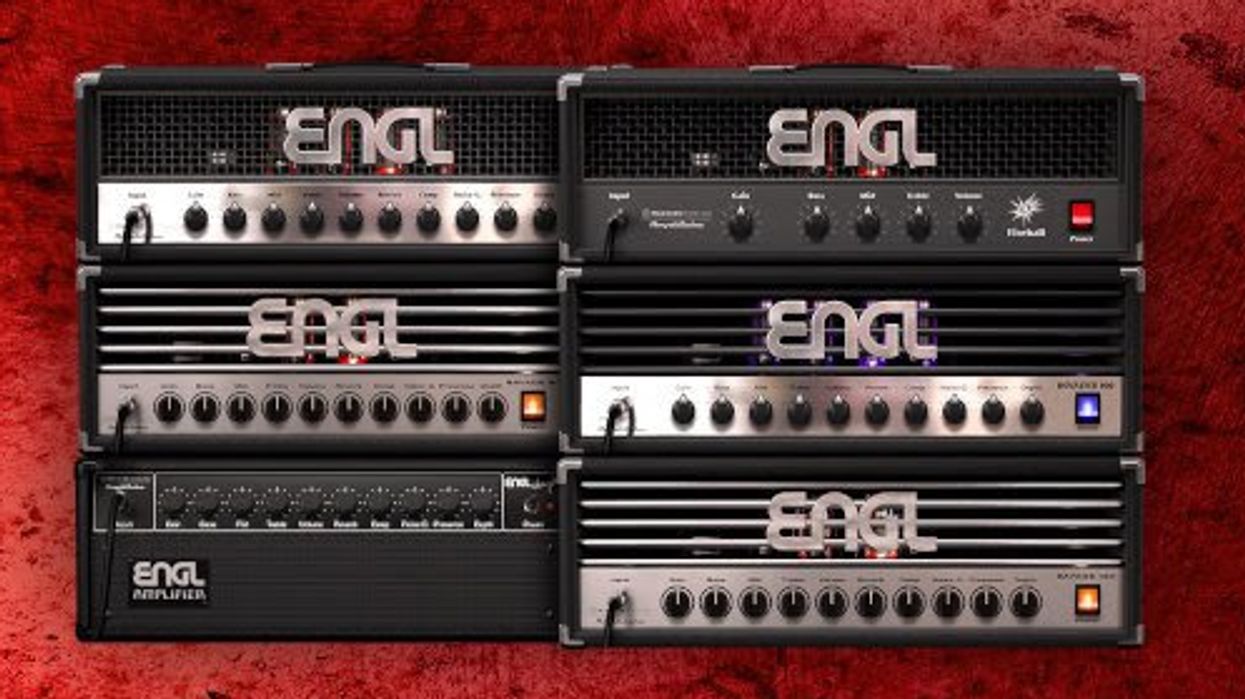
IK Multimedia introduces ENGL Ampthology Vol 1, the first Signature Collection powered by the new TONEX Modeler. ENGL has earned a place among the most revered names in high-gain amplification, with a tone that has shaped the performance of metal, prog, and hard rock around the world.
For the first time, that signature ENGL aggression and clarity have been captured directly from ENGL's private vault of hand‑selected amps, meticulously curated for the official TONEX collection.
"For decades, ENGL has defined the sound of high-gain excellence. With IK Multimedia's TONEX technology, our iconic amps have been captured for you to unleash in the studio, on stage, or anywhere your music takes you."
- Edmund Engl, founder of ENGL AMPS
ENGL Collection Overview
- 72 Tone Models based on six legendary amps from ENGL's private collection, dialed in for this exclusive release.
- Created by ENGL tone masters using TONEX Modeler for enhanced high‑gain precision.
- Includes Amp, Amp + Cab, and Complex Rig Tone Models for ultimate flexibility in studio and live setups.
- Compatible across the entire TONEX ecosystem: Mac/PC, iOS, TONEX Pedal, and TONEX ONE.
- Compatible with all TONEX software versions, including the free TONEX CS.
The Ultimate ENGL Experience
ENGL Ampthology Vol 1 offers instant access to six legendary ENGL amplifiers: the Fireball 60, Powerball MK1, Invader 100, Savage 120 MK1, Savage 60 MK1, and the pure tube tone of the ENGL Straight. Each amplifier offers a selection of exclusive Tone Models, including amp-only captures for maximum versatility.
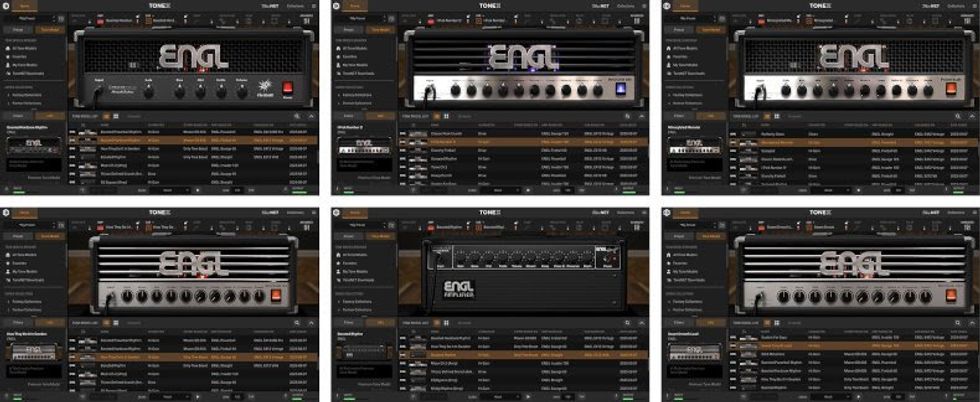
From crystal-clear cleans to crushing high-gain tones, with or without cab, these Tone Models capture authentic ENGL character in a mix-ready, studio-quality format that's phase-perfect, ultra-responsive, and optimized for both studio and live use.
Experience the full ENGL sound - without the volume, weight, or tube maintenance.
Pricing and Availability
The ENGL Ampthology Vol 1 is now available via ToneNET and within any version of TONEX for Mac/PC at a limited-time introductory price of $/€79.99* (reg. $/€99.99).
*Pricing excluding taxes.
For complete details and information about the ENGL Ampthology Vol 1 Signature Collection and to hear the tones, please visit:
www.ikmultimedia.com/tonex-engl-vol1
www.ikmultimedia.com/tonex-engl-vol1/video
Small Amps, BIG Sound: Spark Mini, VF-1, Jupiter 45 & Starlite Reverb
From portable digital powerhouses to vintage-flavored tube tone machines, Premier Guitar contributor Tom Butwin puts four very different low-powered amps through their paces.
If you’re a tinkerer searching for new tonal colors, a traveler who needs great sound in a compact package, or a tone chaser looking for the perfect studio companion, one of these amps has you covered. From quiet practice sessions to mic’d-up gigs, sometimes less really is more.
IK Multimedia Launches the New TONEX Modeler
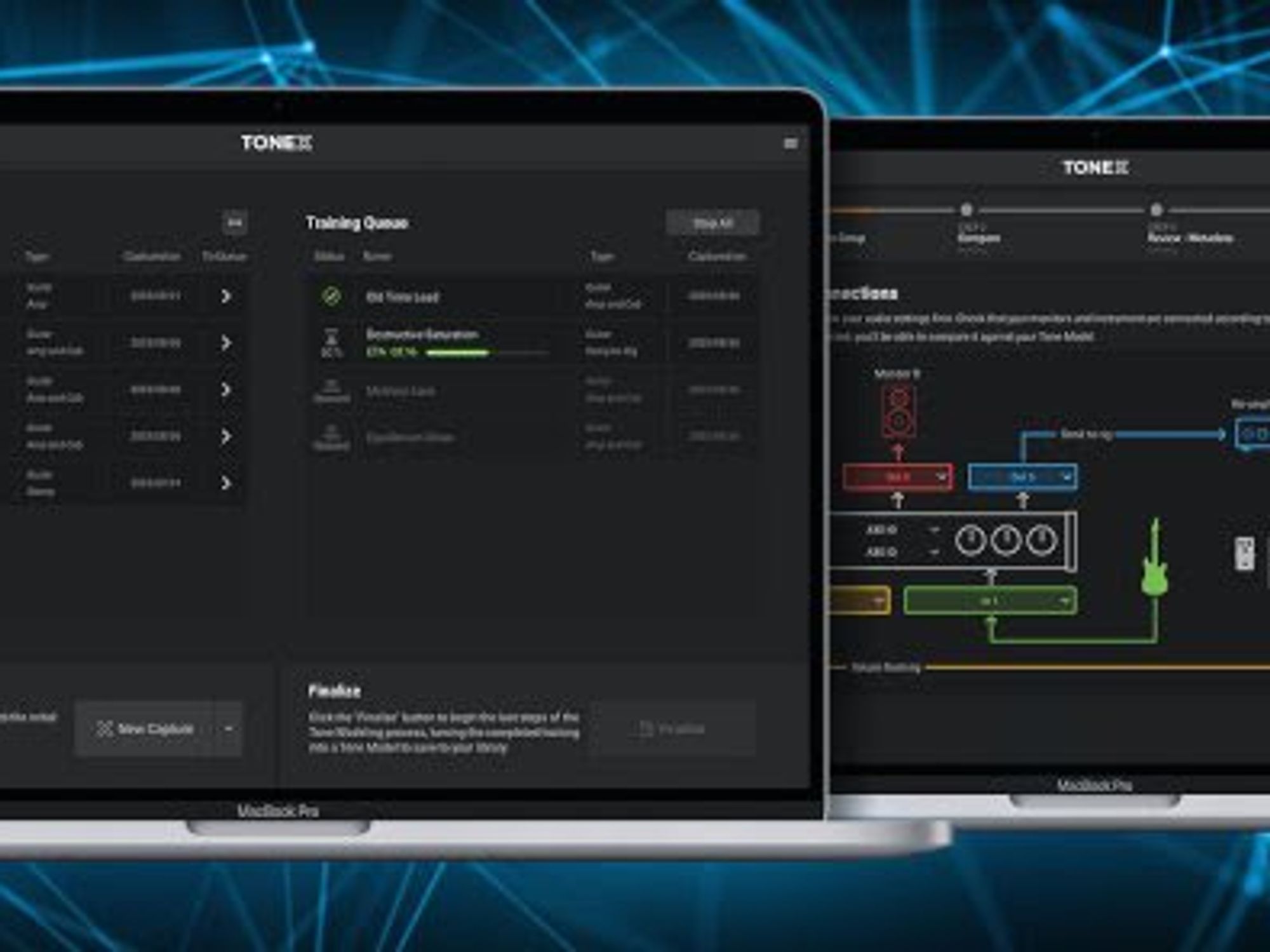
FREE for all TONEX users, the standalone modeler adds batch processing, improves accuracy, increases reliability, and offers dramatically faster training times.
IK Multimedia is proud to announce the launch of the new TONEX Modeler, a FREE update for all paid versions of TONEX, available today through the IK Product Manager as TONEX 1.10.0.
Smarter. Faster. Perfect Tone.
Developed by IK's dedicated TONEX team, TONEX Modeler offers a variety of requested improvements and works seamlessly with TONEX software, ToneNET, and TONEX hardware, whether for capturing and creating Tone Models or performing live with more accurate and expressive Tone Models.
TONEX Modeler Overview
- Faster Training: Up to 87% quicker on modern GPUs and Apple Silicon Macs, with training times as short as 2 minutes.
- Extreme Tone Accuracy: Ultra-dynamic with harmonic clarity for high-gain amps.
- Batch Processing: Capture multiple rigs in a single session, then train later, even on another machine.
- Time-Saving Workflow: TONEX Modeler automatically stops training once the ideal results are achieved.
- Phase-Perfect Captures: Stereo rigs and DI blends remain perfectly aligned, essential for live performance.
- Ultra-Low Latency: Play with a natural, responsive feel both in the studio and on stage.
- Portable & Organized: Archive, export, and transfer captures easily across devices.
- Seamless TONEX Integration: Instantly load new models into TONEX and TONEX Editor.
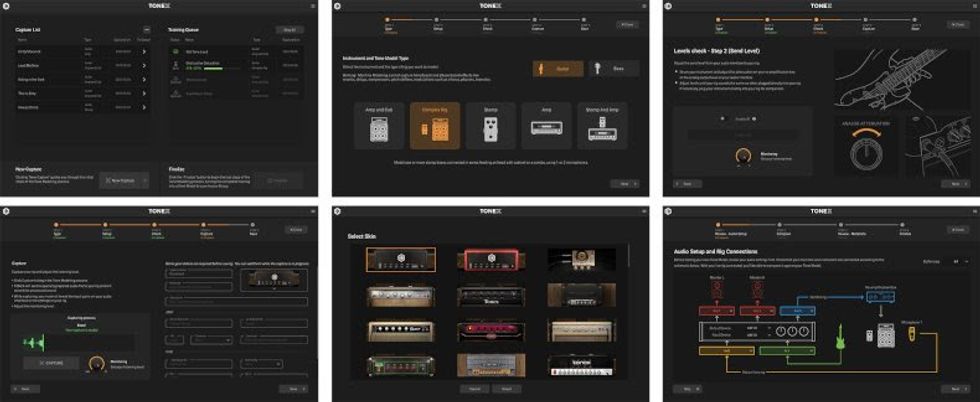
Professional, Unmatched Results
Every Tone Model produced by TONEX Modeler is phase-perfect and features ultra-low latency, ensuring that stereo rigs and bass DI blends sound flawless without requiring additional tweaks. The new capture engine also excels with high-gain tones, delivering tighter lows, richer harmonics, and crystal-clear definition-perfect for modern guitarists and producers who demand mix-ready sound straight from the capture.
Batch Processing for Power Users
TONEX Modeler's batch processing removes guesswork, saves time, and lets users capture once and process anytime, with the heavy lifting done automatically. Designed for today's creators, it works smoothly with NVIDIA GPUs and Apple Silicon Macs, providing faster and more reliable performance. Its smart workflow even stops training early once peak quality is reached, so there's less waiting and more creating.
Tone Partners Onboard
TONEX Tone Partners are experts whose feedback was crucial in developing the new TONEX Modeler. They received early access, and today IK is excited to share the results of this collaboration. Fifty-six new Tone Partner collections and bundles are now available on ToneNET for demo and purchase, showcasing the sonic enhancements of the new TONEX Modeler and providing over 1,140 new Premium Tone Models of sought-after rigs to explore.
Pricing and Availability
The TONEX Modeler is now available through the IK Product Manager as a FREE update for all paid versions of TONEX, including TONEX SE.
TONEX Tone Partner Collections, created with the new TONEX Modeler, are now available for demo and purchase through ToneNET and in any version of TONEX for Mac/PC, starting at just $/€9.99* with Tone Partner bundles beginning at $/€39.99.
How to Mic Acoustic, Electric, or Bass Guitars like a Pro
In this video, PG Contributor Tom Butwin breaks down the fundamentals of mic'ing acoustic, electric, and bass guitars. Learn the best microphone placements to capture the perfect tone, whether you're looking for a bright, aggressive sound or a warm, vintage vibe.
Molly Tuttle: Moving Beyond Bluegrass Into Fresh Pop Pastures
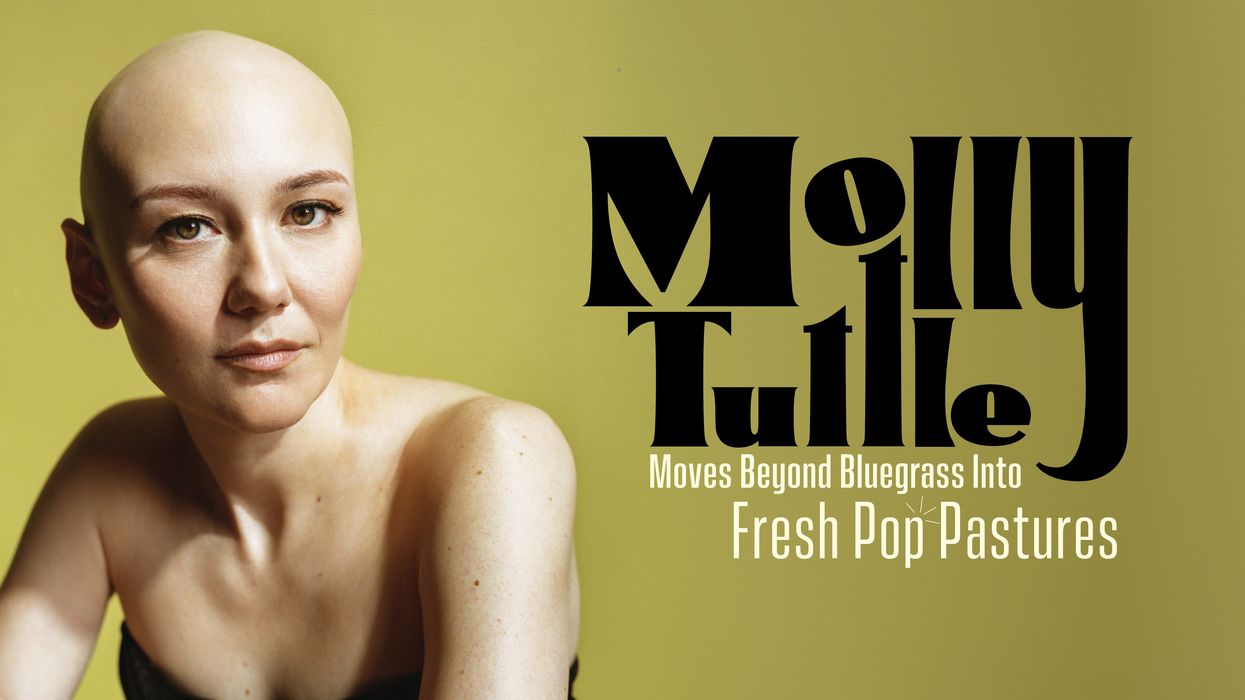
Perched on Houston Street, the unofficial border between Manhattan’s East Village and Lower East Side, the Mercury Lounge is a venerable New York City music room with a top-notch sound system. It’s also quite small. Two hundred and fifty people max would be a generous capacity estimate, and the club’s bookings, fittingly, tend toward the alternative and the fringe. So it’s not the first place you’d expect to see a celebrated bluegrass acoustic guitar virtuosa and two-time Grammy winner. But on this extra-warm evening in late June, Molly Tuttle is specializing in the unexpected.
- YouTube
The four musicians weaving through the shoulder-to-shoulder crowd ahead of Tuttle to the Mercury stage are the night’s next surprise, for more than one reason. For starters, they’re not Golden Highway, the group with which she won those Grammys (for Best Bluegrass Album, in 2022 and 2024). Secondly, they’re all female. The appealingly afro’d Megan Jane is a stone-solid drummer. Vanessa McGowan switches off between electric and acoustic upright bass. Mair Mulroney deftly handles fiddle, mandolin and keyboards. Close-cropped Ellen Angelico lets it rip on electric guitar and lap steel. “This is only the fourth show we’ve played together,” Tuttle announces from the stage, clutching the signature dreadnought that Martin built for her last year. “And the first three were festival-type things, so this is the first show that really feels like ours.”
The music they play, much of it from Tuttle’s new album, So Long Little Miss Sunshine, is surprise number three. Bouncy, breezy songs like “The Highway Knows” and “That’s Gonna Leave a Mark” are, in short, not bluegrass, though they abound with nods to both modern and traditional country. You wouldn’t be wrong to call this pop music, yet it’s pop of an exceptionally tuneful, intelligent and tastefully arranged order. And unlike the work of pretty much any other contemporary pop artist, it leaves plenty of room for the acoustic guitar as a lead instrument. Because while the stylistic trappings and the supporting players have changed, one thing hasn’t: Tuttle is still cross-picking up a storm, exclusively on the kinds of axes that have big sound holes and wound G strings. At least for now.
“Maybe on the next album,” 32-year-old Tuttle says with a laugh earlier that same day, in a mercifully air-conditioned record company conference room, when asked about the chances of her ever going electric. Right now she’s still happy to explore her usual instrument in a new context. “You know, you think of bluegrass as featuring the flatpicked guitar more than any other style. But strangely enough, I play so much more guitar on this album than I ever have on one of my records. That was really fun for me, and it pushed me as a player. It was like, how do we keep this interesting when I’m gonna be the only soloist on the whole record?”

“This is my fifth record,” Tuttle says of So Long Little Miss Sunshine, “which is crazy. It doesn’t feel like it is. But looking at all five of them together, this one is definitely more in the vein of my first record [2019’s When You’re Ready] and the cover record. And then for the last two”—the Grammy winners, Crooked Tree (2022) and City of Gold (2023)—“I consciously wanted to make these bluegrass records to honor my family roots in that music. My grandfather played the banjo and passed down the music to my dad, who taught me how to play, and it just felt like this important thing for me to do. I know that I’ll always want to play that music, and I’m sure I’ll make more bluegrass records and tour with bluegrass bands again. But at the same time, this album feels like it’s a bigger picture of who I am as an artist. It encapsulates more sides of my songwriting and playing and singing.”
“Strangely enough, I play so much more guitar on this album than I ever have on one of my records.”
So where does this leave Golden Highway? “It’s on hiatus,” Tuttle responds, “and I don’t know when we’ll play together again. But I certainly hope that we do. I think we were all ready to slow it down a bit. We’ve had so much fun over the past three years, but everyone knew that I was gonna want to do something different. Some of the band members expressed that they wanted to pursue their solo projects, and we’ve been touring at such a high intensity, it just felt like a natural stopping point. I don’t think anyone wanted to say this is the end, and I certainly don’t. We’re all still great friends, I see them around in Nashville, and I think when the time’s right, we’ll have an epic musical reunion.”
Molly Tuttle’s Gear
Road Guitars
Pre-War Guitars Co. Dreadnought (tuned EADGBD)
Martin Molly Tuttle signature model (D-28 style, tuned DADGAD)
Studio and Home Guitars
1943 Martin D-18
Pre-War Herringbone and Double Aught
Preston Thompson D-BA
Preston Thompson Molly Tuttle Signature
Pickups
K&K Double Helix, blended with internally mounted Shure microphone
K&K Pure Mini
L.R. Baggs HiFi Duet
Grace Design FELiX preamp
Strings, Picks & Capos
D’Addario EJ12 80/20 Bronze strings, medium gauge (.013-.056)
Dunlop Jazztone 208 picks
Shubb and Elliott capos
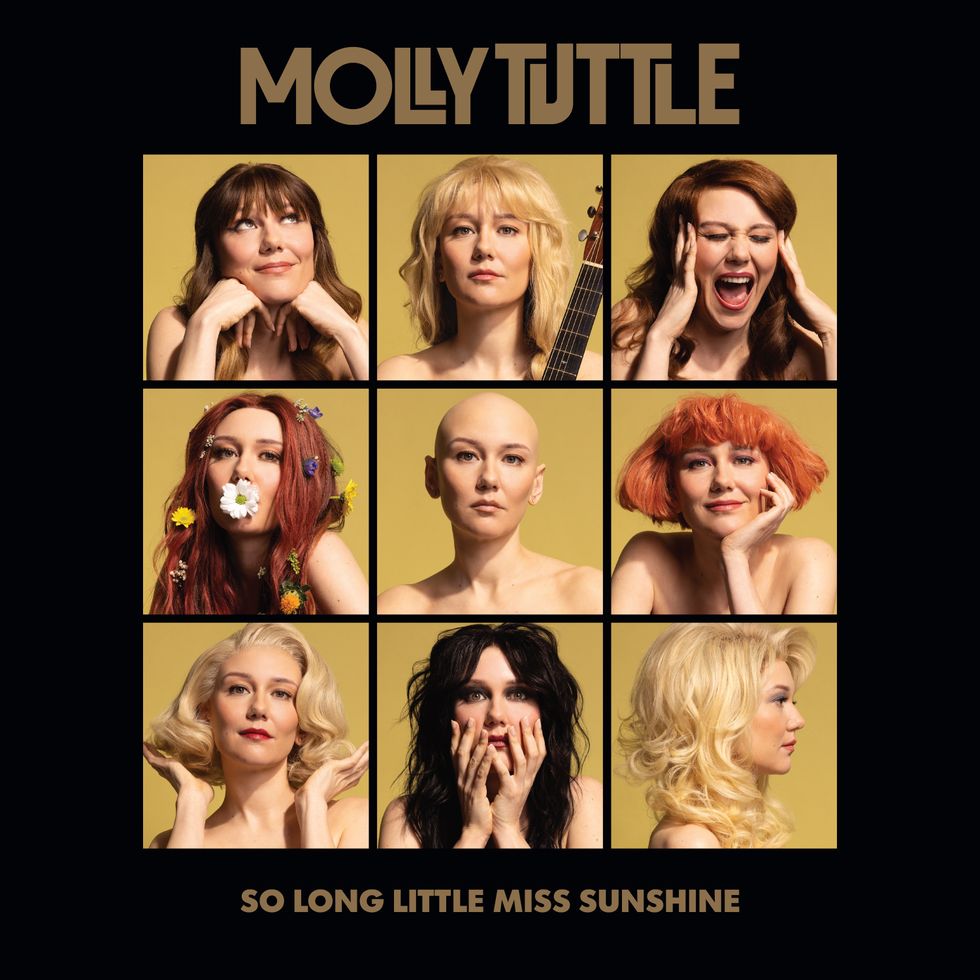
As for the new band, Tuttle claims that the lack of Y chromosomes in its lineup wasn’t pre-planned. “I reached out first to Vanessa, who’s playing bass, and then she connected me with the rest of the band. I’d already toured with Megan, the drummer, in 2021, and we did some pandemic livestreams together. But we didn’t mean to make it all-female. Being a woman in the music industry, you never want to feel like you’re being asked for a gig just because you’re a woman. But when you get together organically, as we did, it’s like, yay, this is pretty fun.” That sense of high spirits is evident at the Mercury Lounge, as Tuttle’s bandmates prove equally adept at both the poppier new material and Golden Highway nuggets like “Alice in the Bluegrass” and “Over the Line.”
“I’m sure I’ll make more bluegrass records and tour with bluegrass bands again.”
Tuttle may not have played any of the electric guitar parts on So Long Little Miss Sunshine (those were handled by Joyce), but in the absence of Golden Highway in the studio, she did make another notable recorded debut: playing her grandfather’s banjo. “I always had a banjo player before,” she explains, “but all of a sudden I had to be my own banjo player. And that was a conscious decision—we still wanted to have banjo [on the album]. That way you see how it connects to my previous work; even as we’re moving into new areas, we tie it back to the roots.”
Beyond serving as a timbral bridge from one Tuttle era to another, the banjo also combines with her acoustic to create alluring textures on the album’s final two songs, “No Regrets” and “Story of My So-Called Life.”
In the latter composition, an exercise in elliptical autobiography, Tuttle gives a shout-out to the Orange Line, a branch of the Boston subway system that she rode almost every day she lived there. Even though she’s been a Nashville resident for years, the time she spent in Massachusetts’ capital as a student was clearly pivotal. “I learned so much at Berklee,” Tuttle recalls. “I knew no music theory before I went there. I’d never read any music or tablature. I had such an aversion to all that. So when I got there, it was a big shock. But after about a year I really understood music more, and I could communicate better with other musicians. A lot of times, I was the only acoustic player in my guitar classes, which was kind of funny. But I learned to embrace that, even if it sometimes made me uncomfortable.”
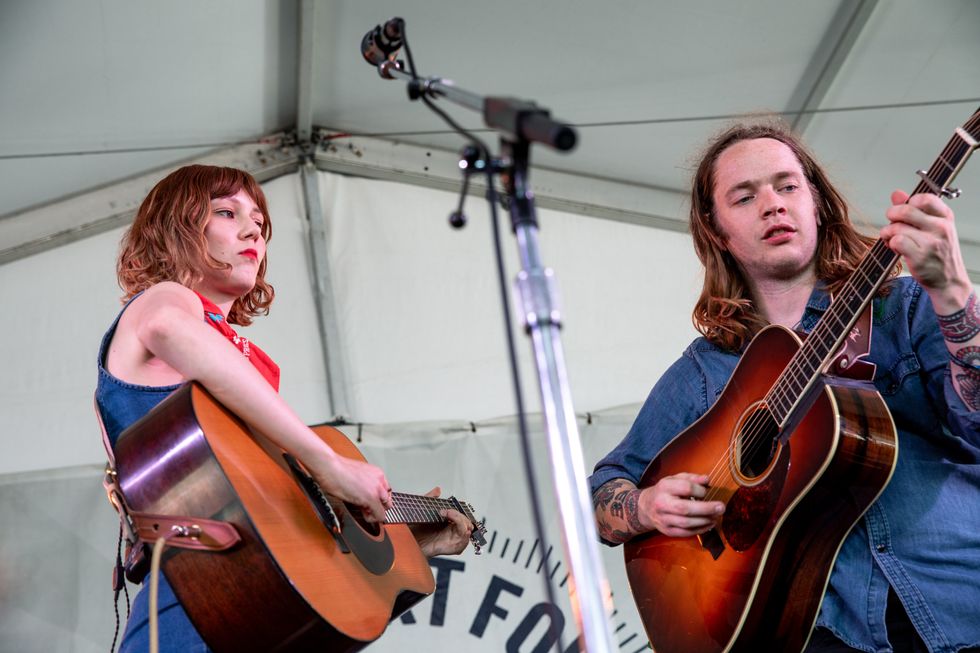
Back at the Mercury Lounge, the surprises keep coming. Toward the end of the set, Tuttle and her band launch into another new tune, “Old Me (New Wig),” with rockabilly swagger. At a climactic moment, Tuttle dramatizes the song’s subtitle by reaching up and removing her carefully coiffed brown wig, revealing a smooth, white pate beneath. What feels on some level like a Sinéad O’Connor-style protest against the patriarchy is also a touching acceptance of reality: Tuttle’s natural hair stopped growing when she was a child due to an autoimmune condition called alopecia universalis. Fans have long known this, but for her to acknowledge it onstage so openly—and play the rest of the show wigless—is further evidence that Tuttle continues to embrace the uncomfortable.
For the last song of the evening, Tuttle plays what feels like her trump card: a radical reworking of Icona Pop and Charli XCX’s “I Love It.” That it’s in the set list isn’t one of tonight’s bigger surprises—it’s a highlight of her new album—but the decision to close with it is bold. Where the original is a snotty dance-punk anthem, Tuttle turns it into something else entirely: a bleak ballad, sung by a woman whose recent romantic breakup may have brought her to the end of her tether. In her hands and voice, a fun pop throwaway becomes strangely moving. It’s a powerful moment, hinting at even more to come.
“I always had a banjo player before, but all of a sudden I had to be my own banjo player.”
“I really liked doing my last two records, the bluegrass ones,” Tuttle says. “That felt so in my wheelhouse. I knew exactly what to do. This one took much longer to figure out: How do I put my own voice on the guitar into this new style of music? And a lot of the songs changed a ton from the way they were when I started writing them.”
She continues, “But now, having these new songs and this new style adds an element that I feel can make the live show bigger and reach more people, which is exciting. And the new band lineup is cool because we can still incorporate the bluegrass stuff too; everyone can play that. For me, it just feels good to branch out artistically.”
YouTube
Molly Tuttle stops into CBS’s Saturday Sessions to play her song “San Joaquin,” from 2023’s City of Gold.

